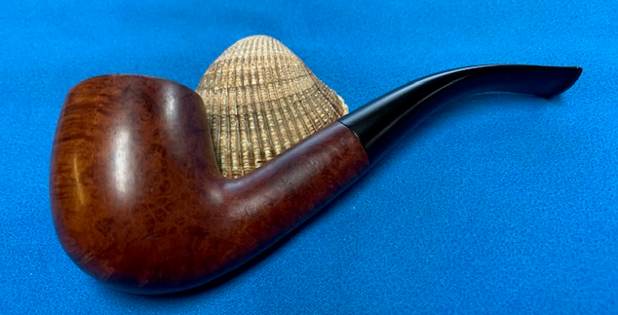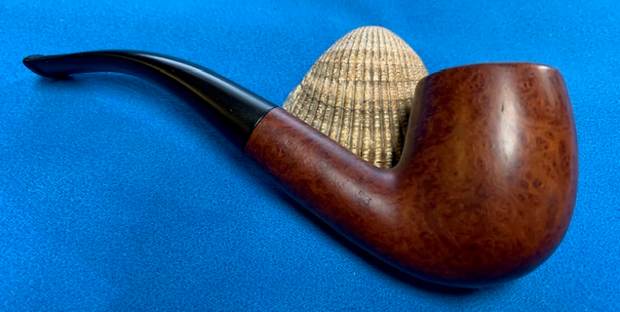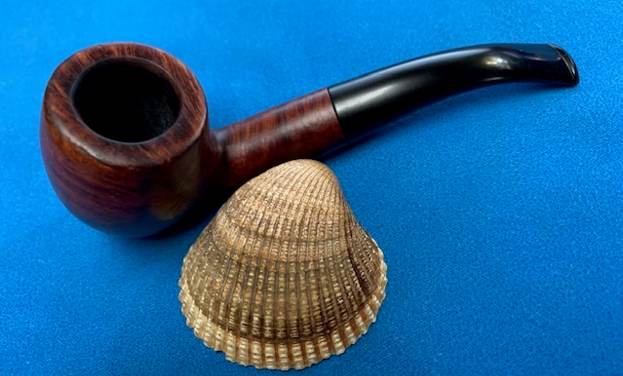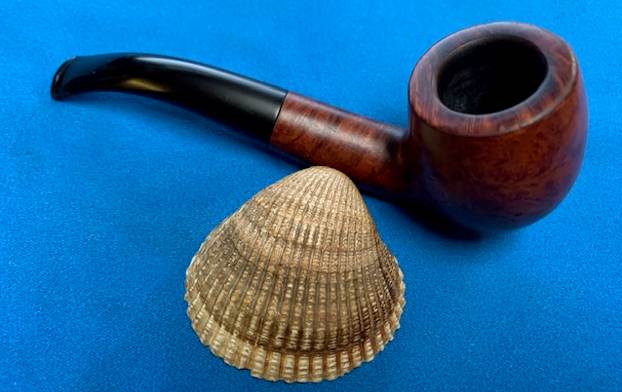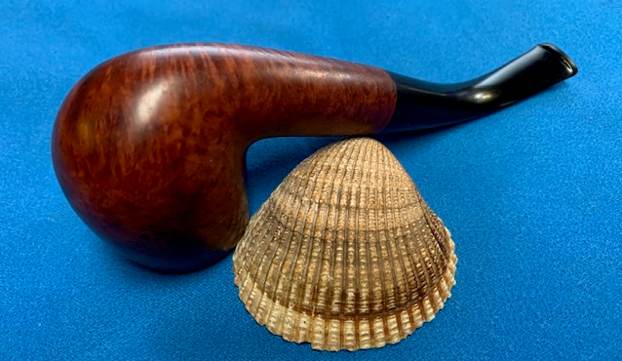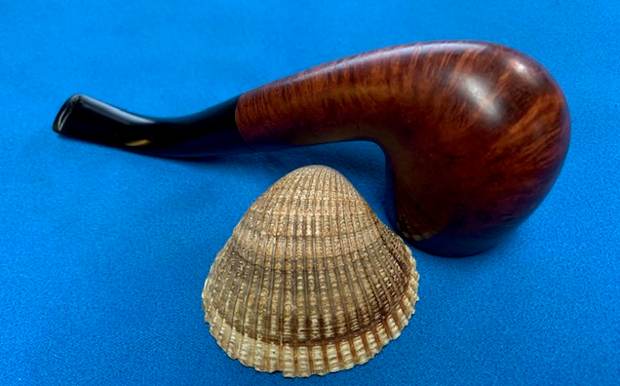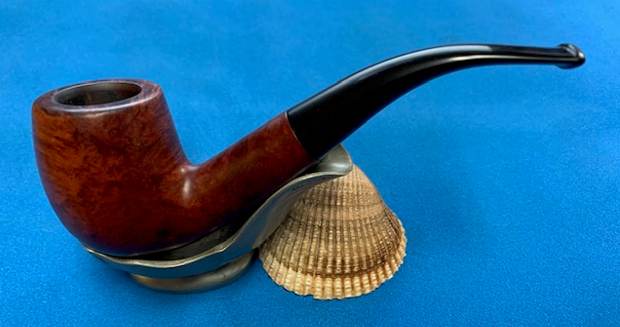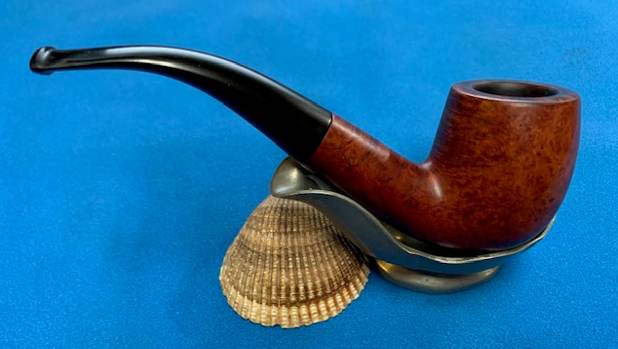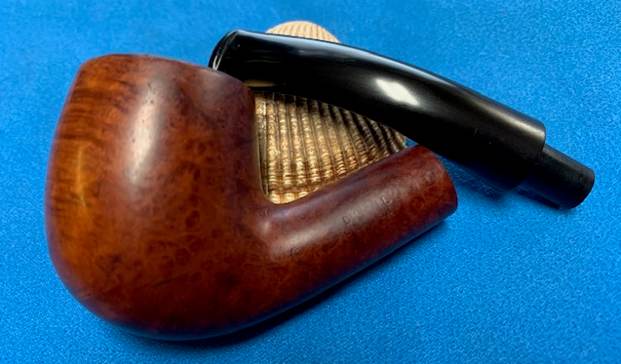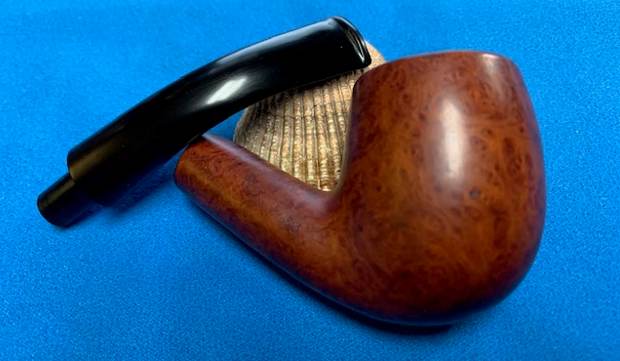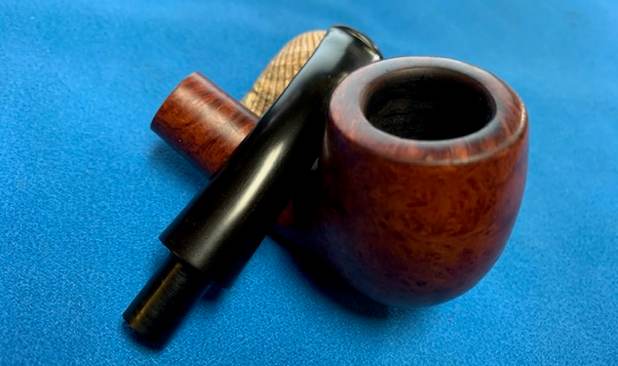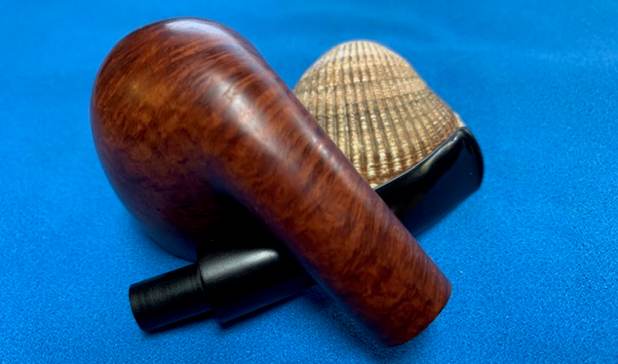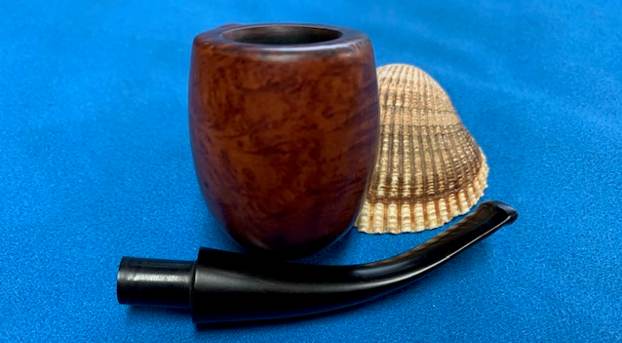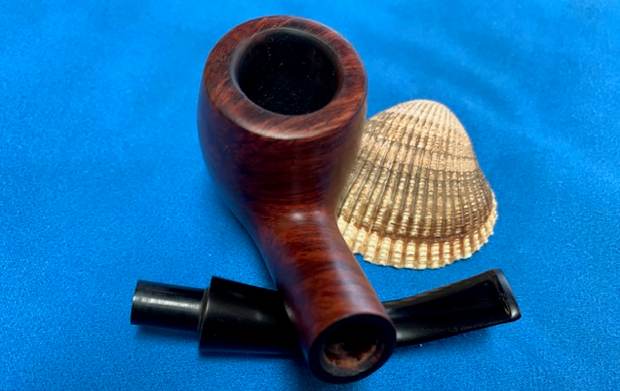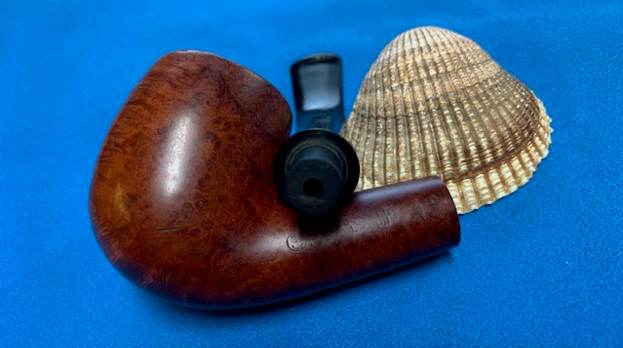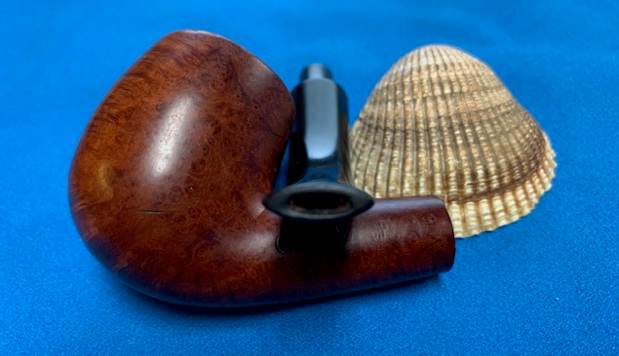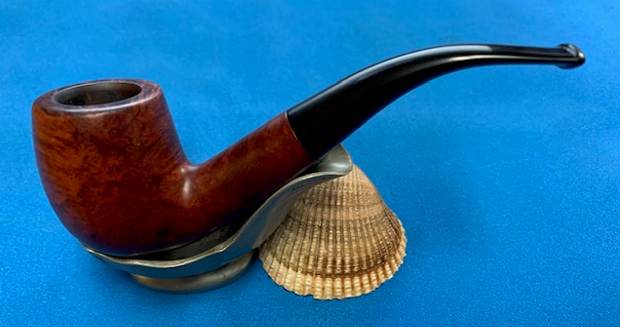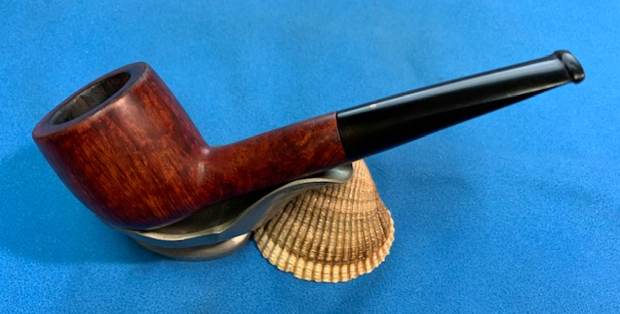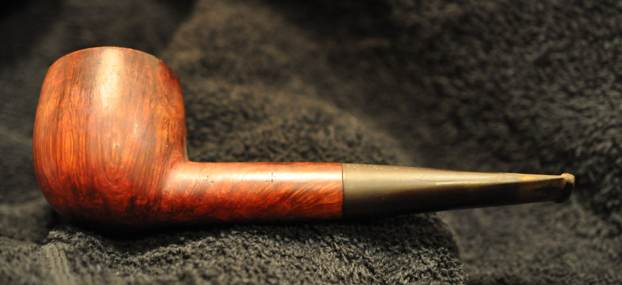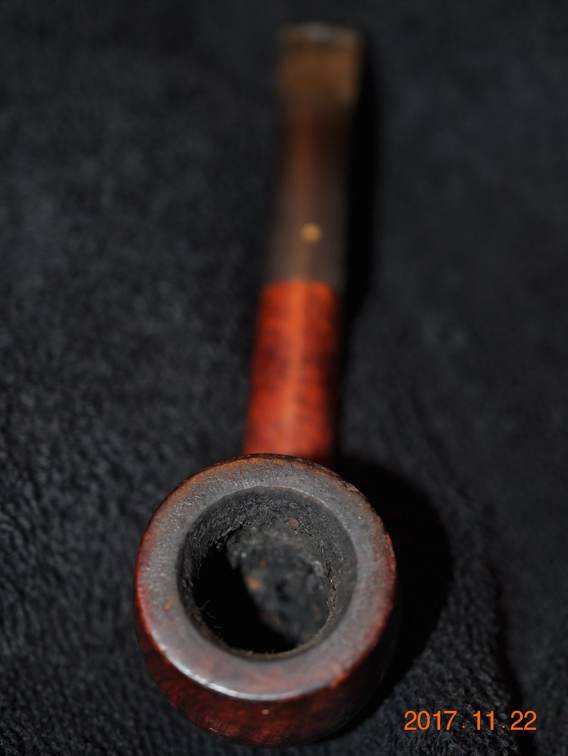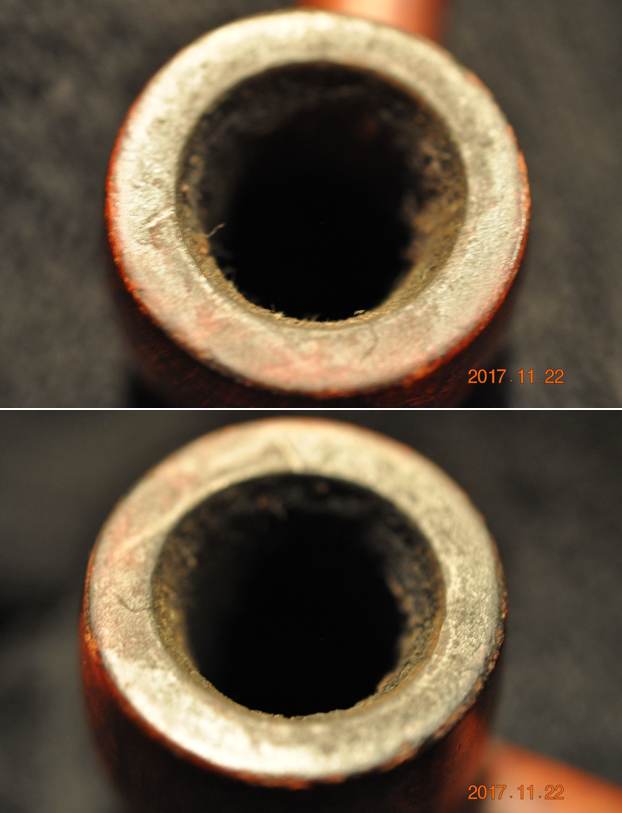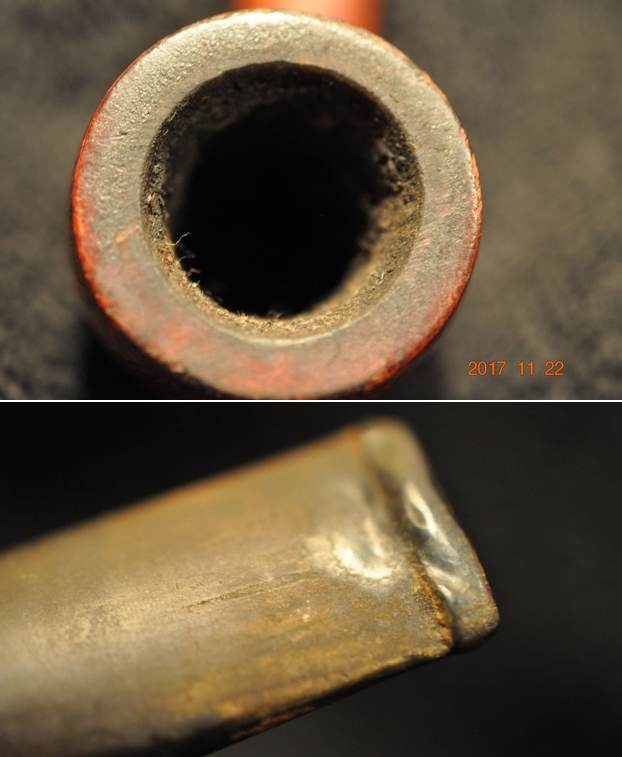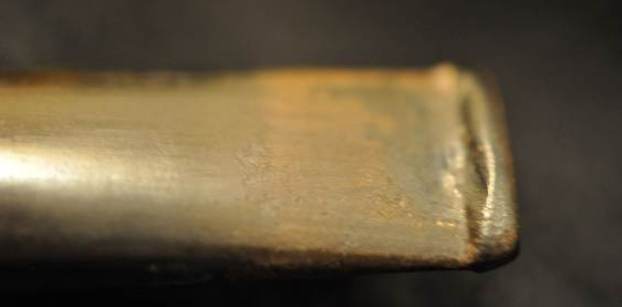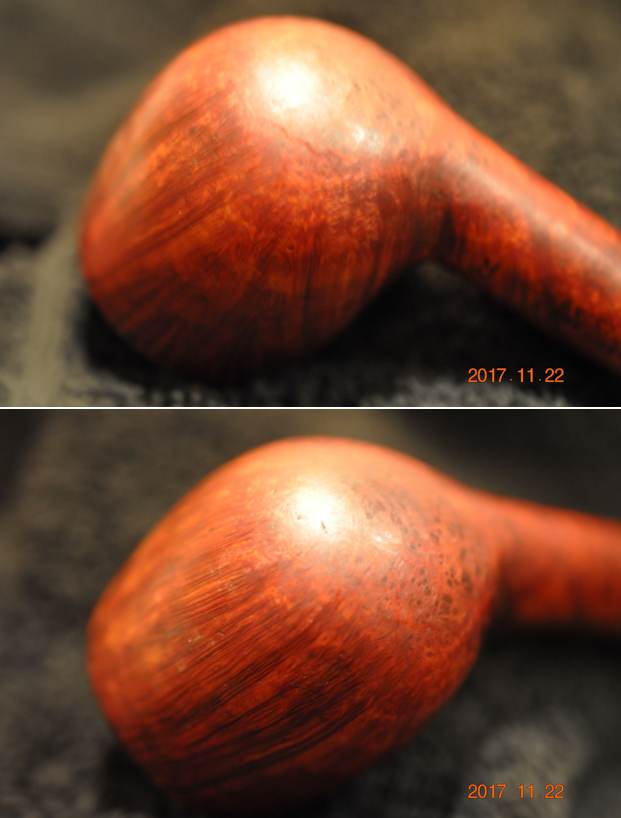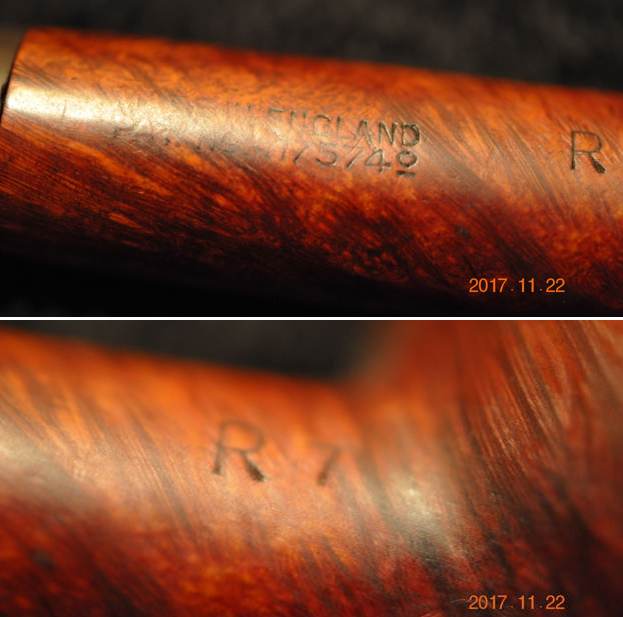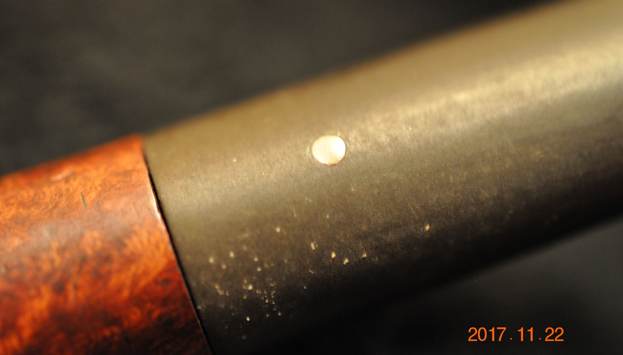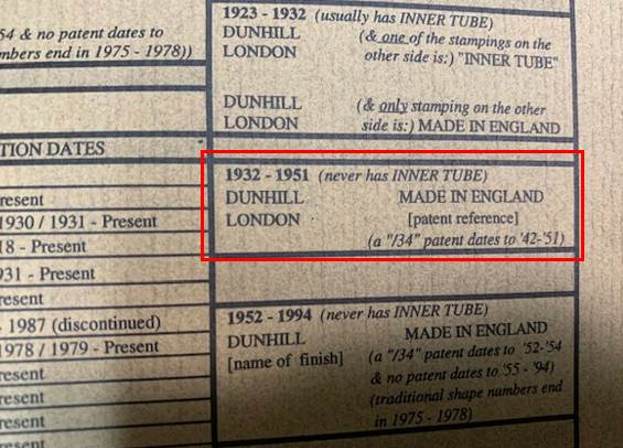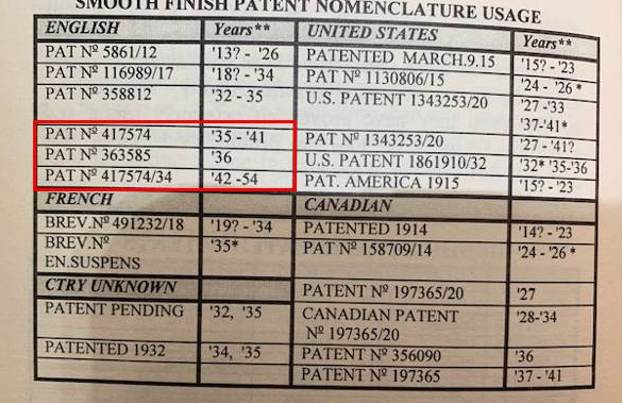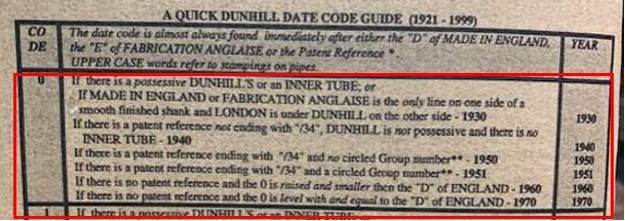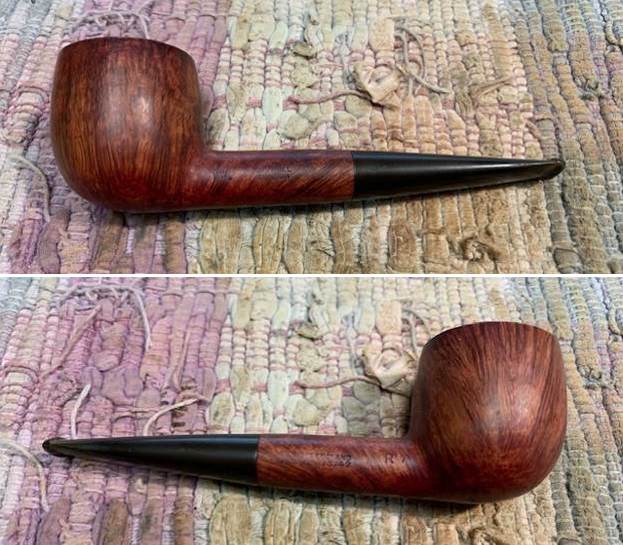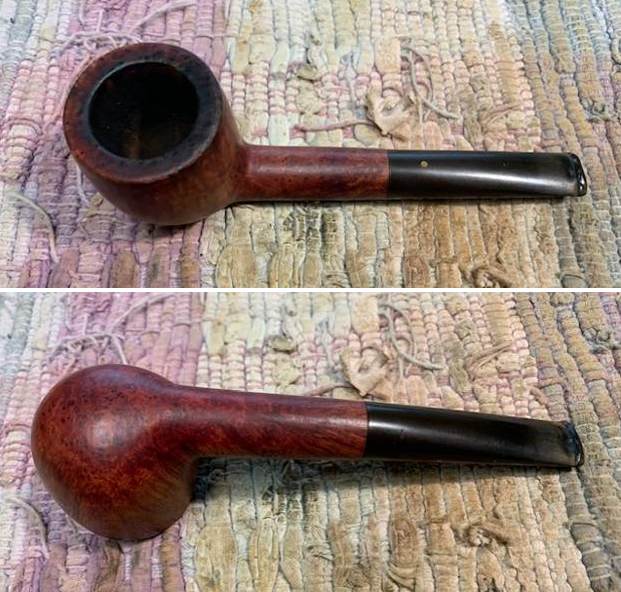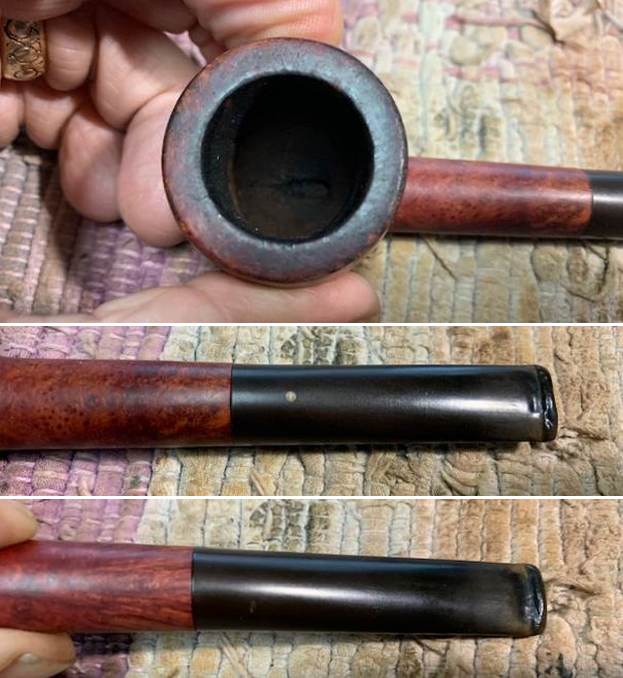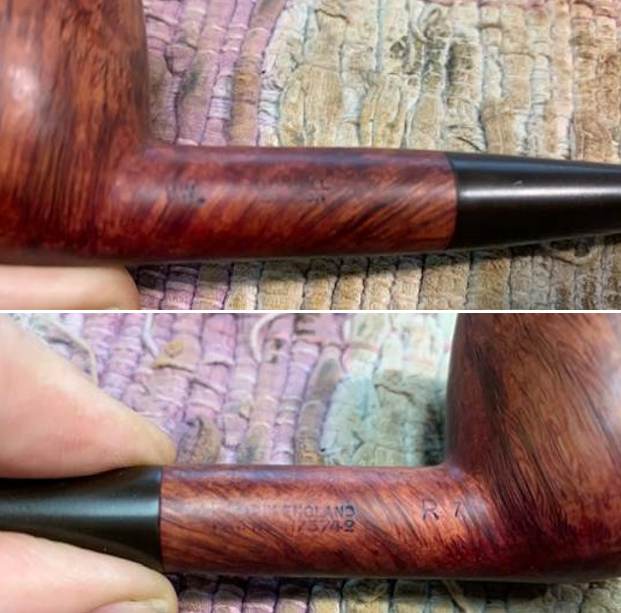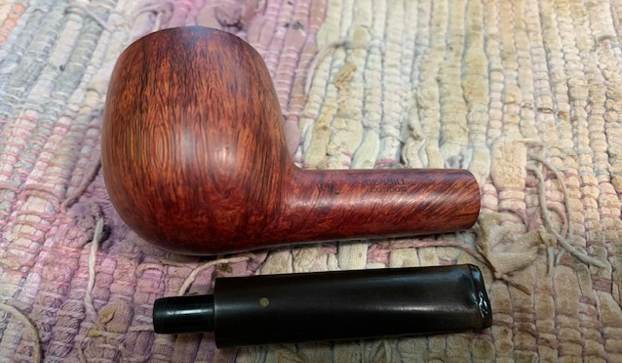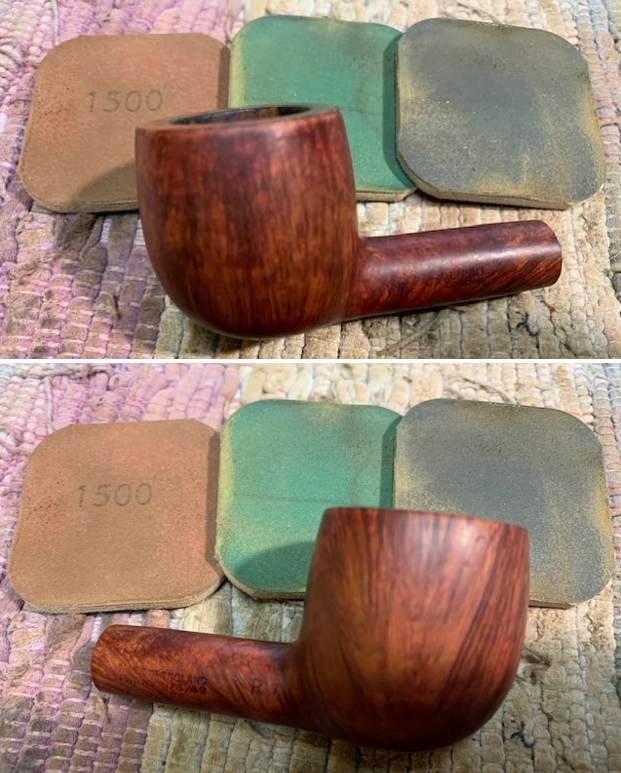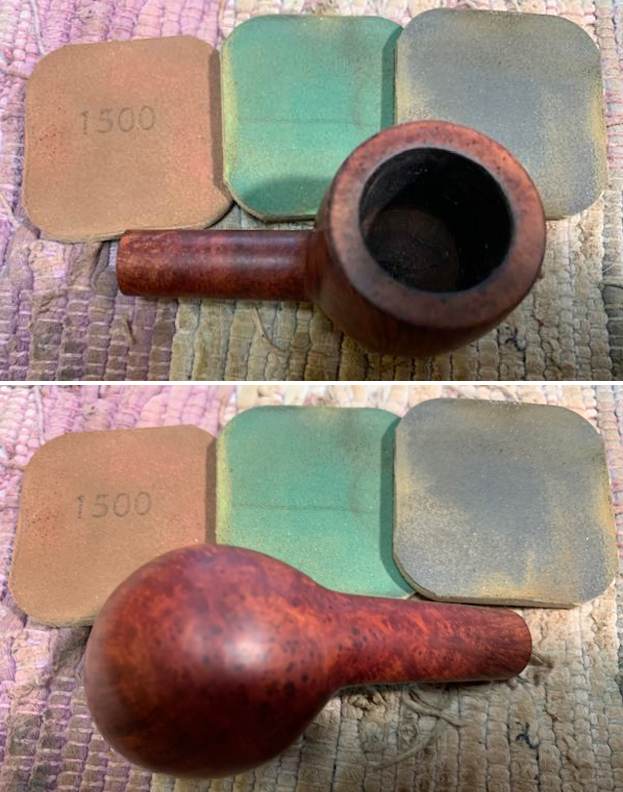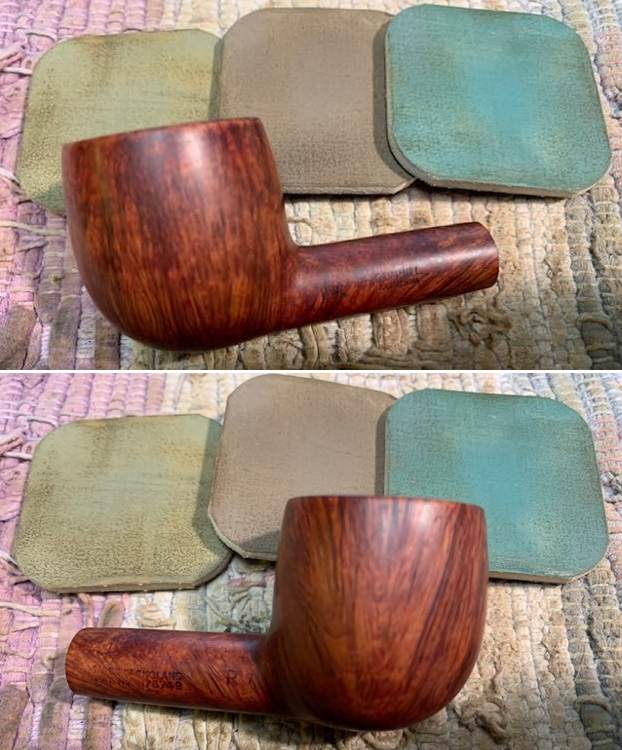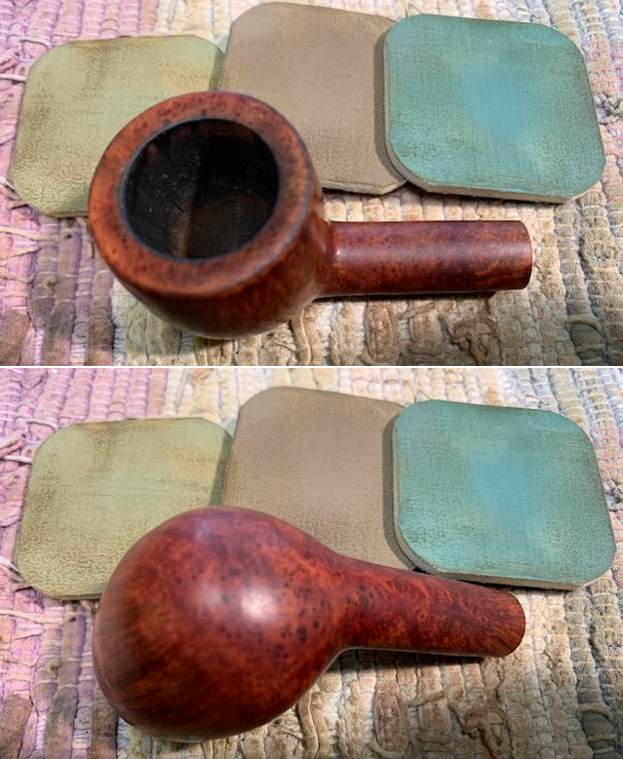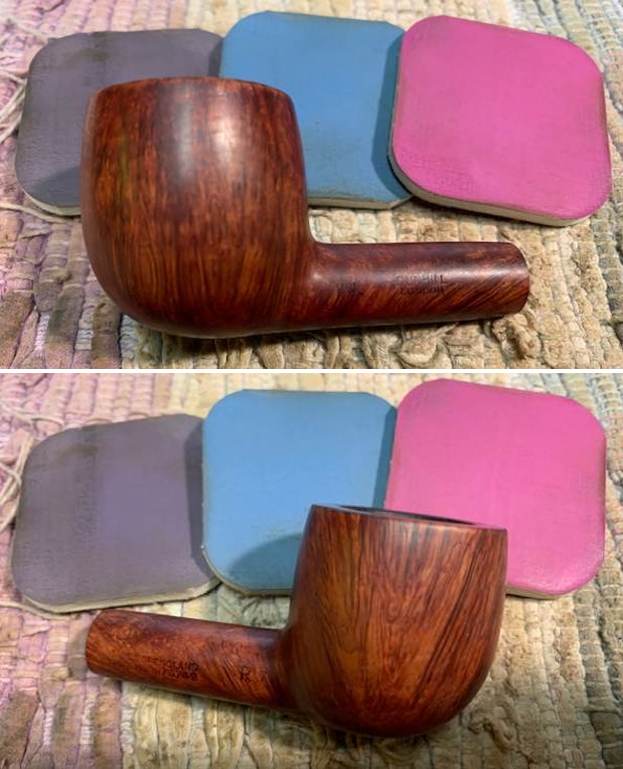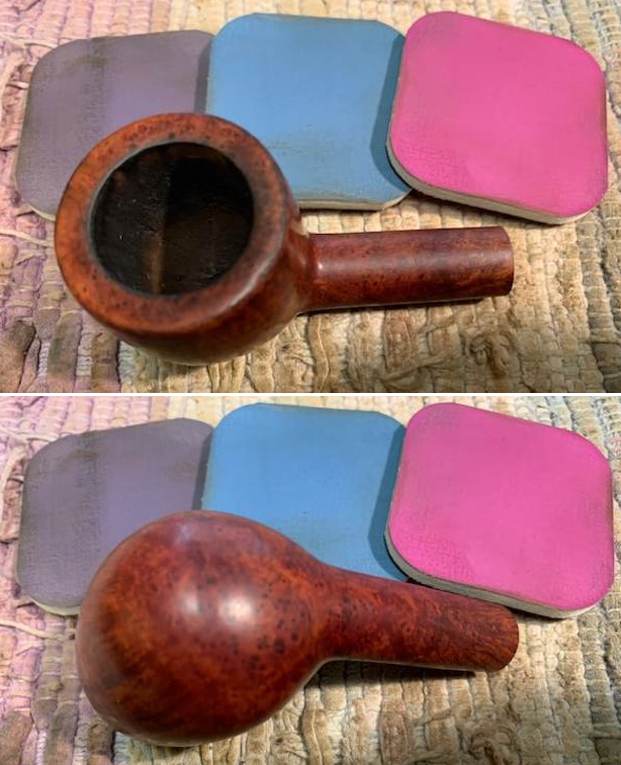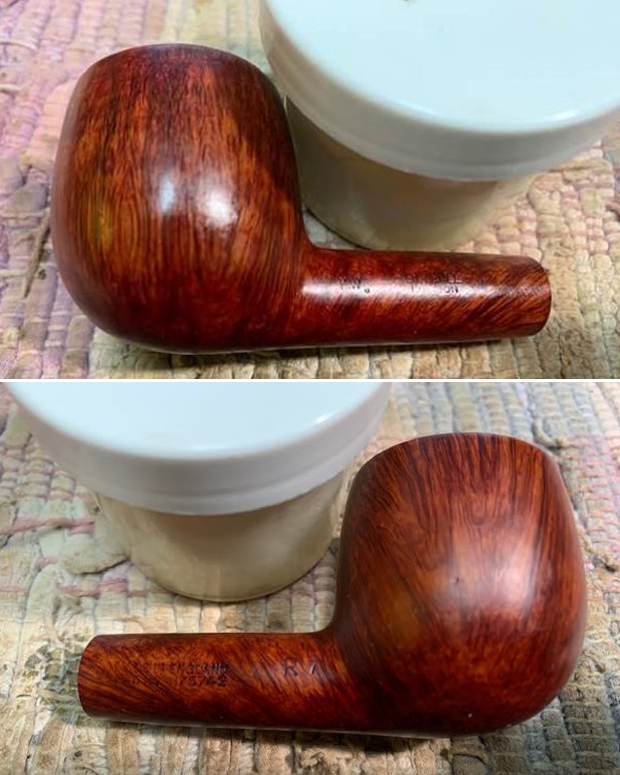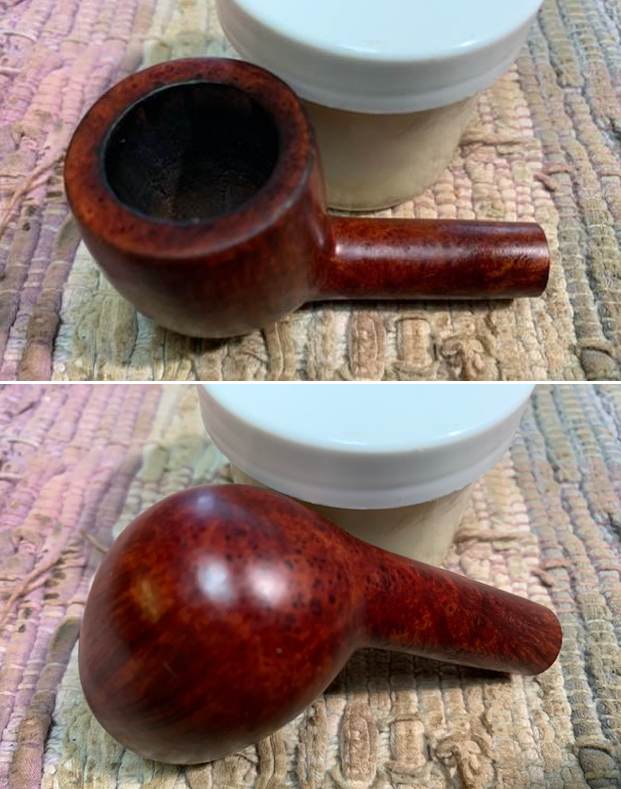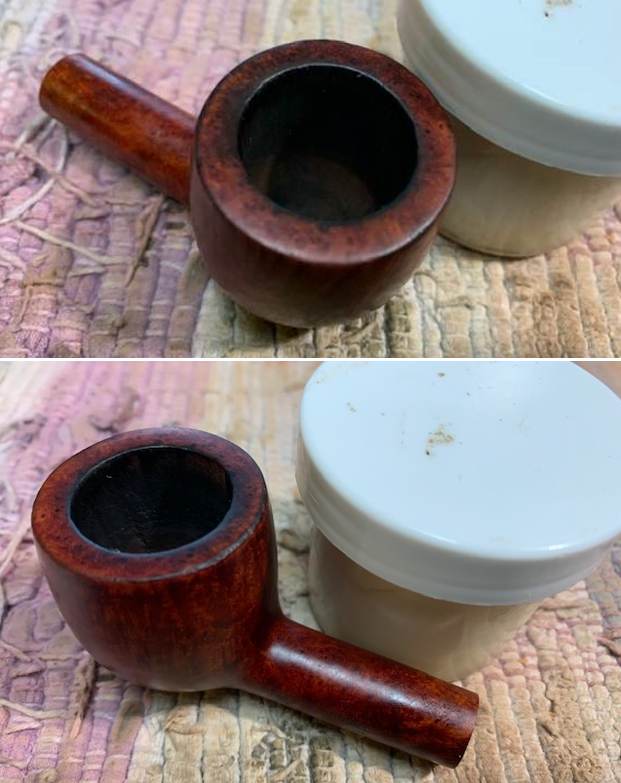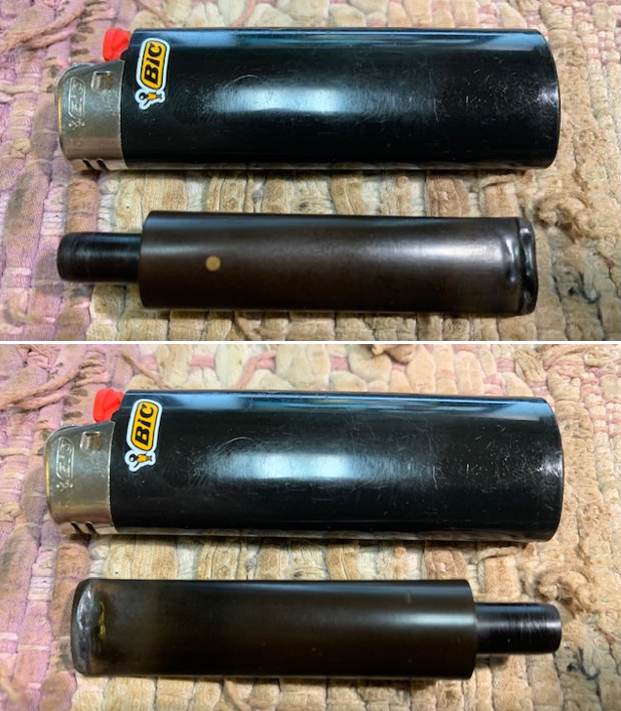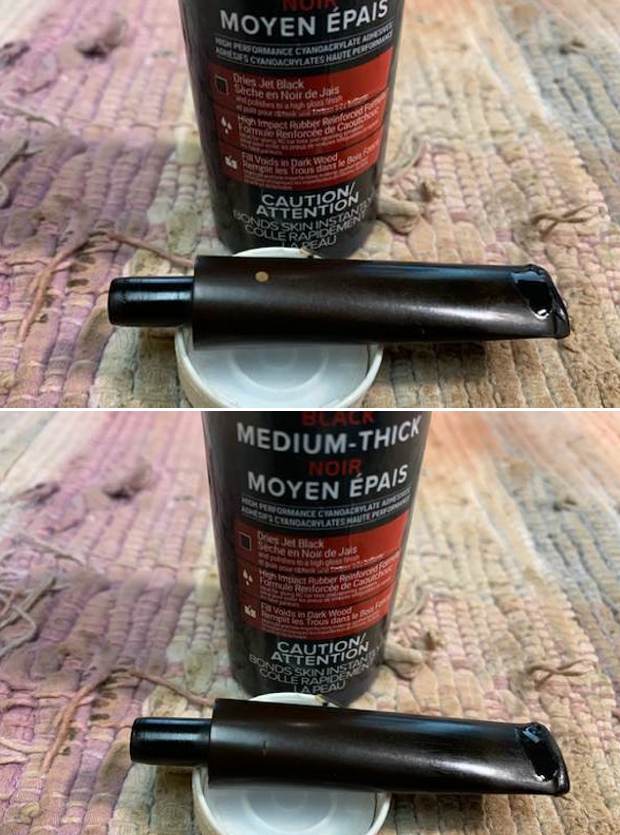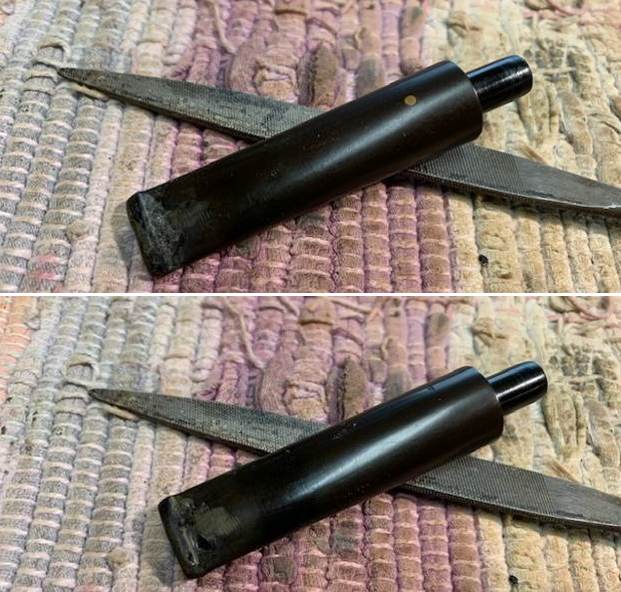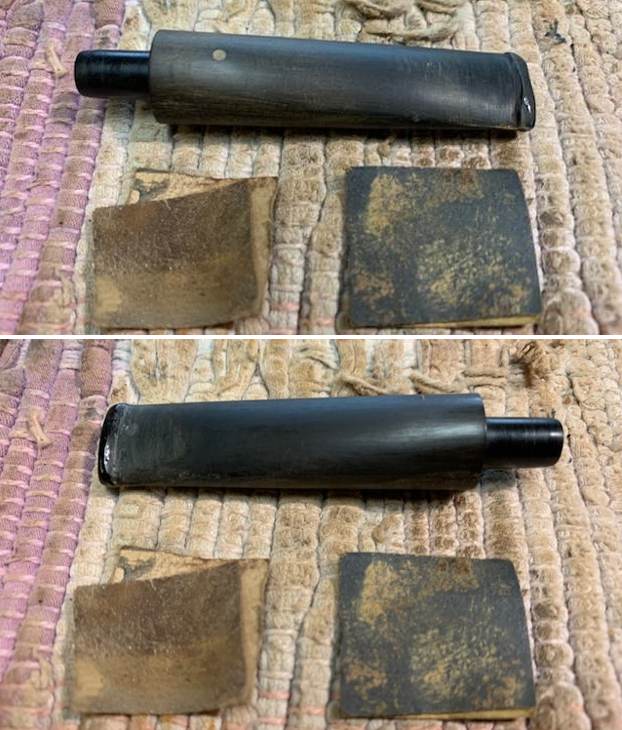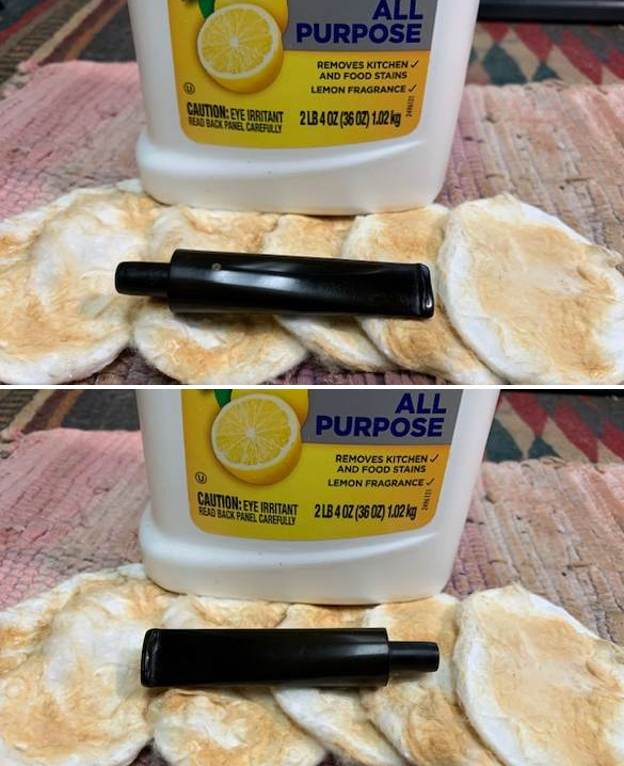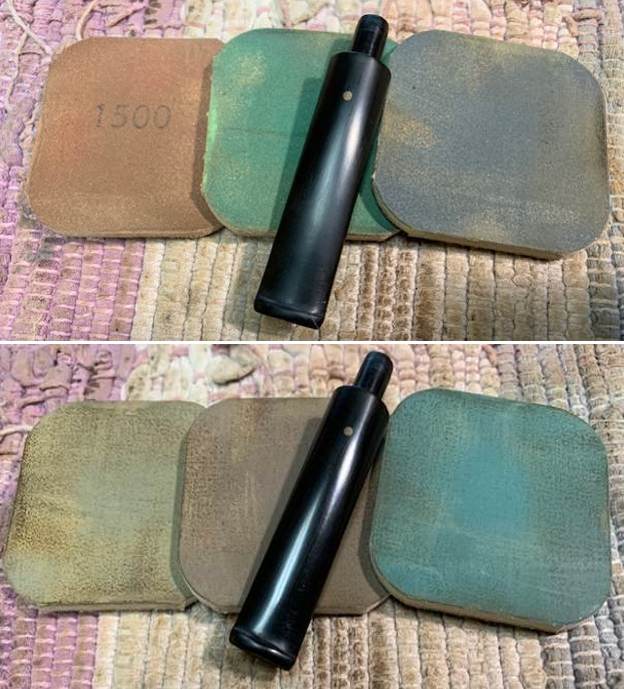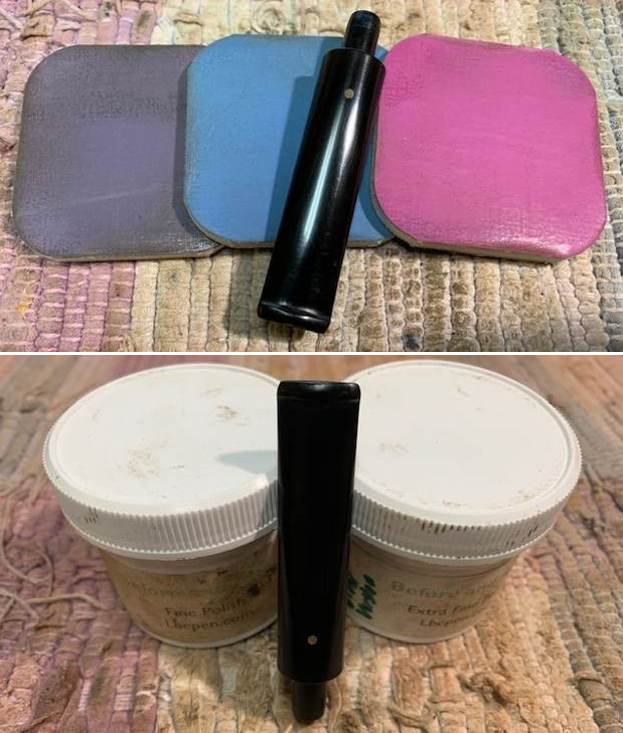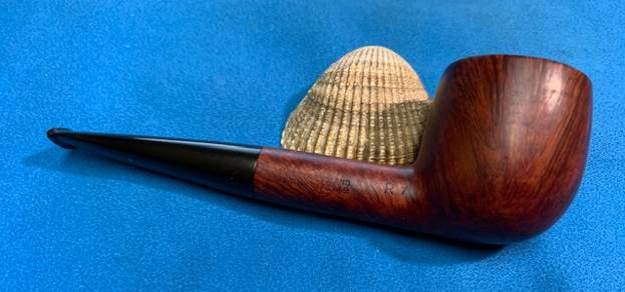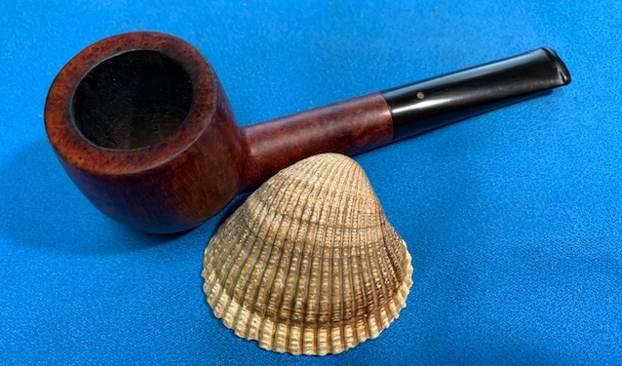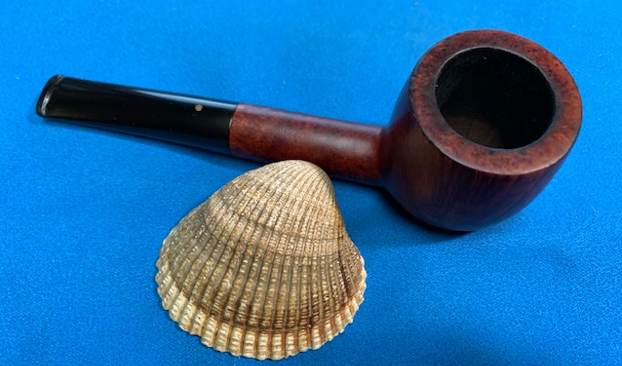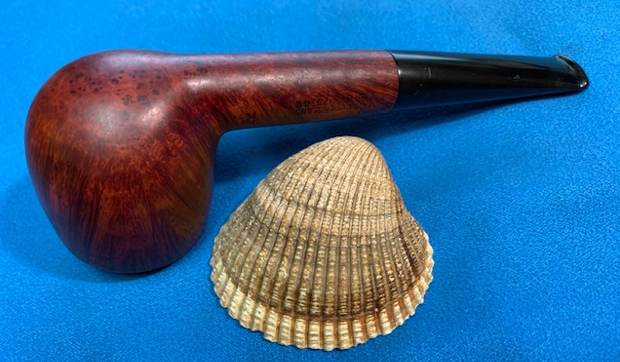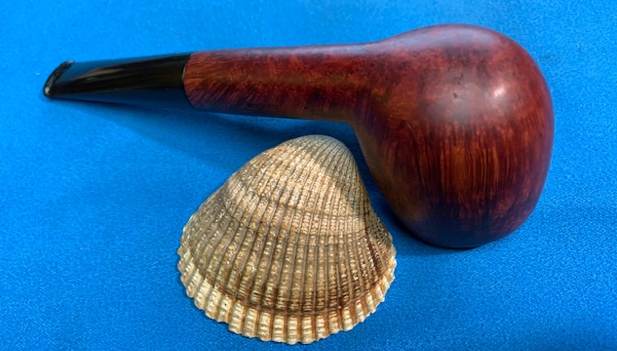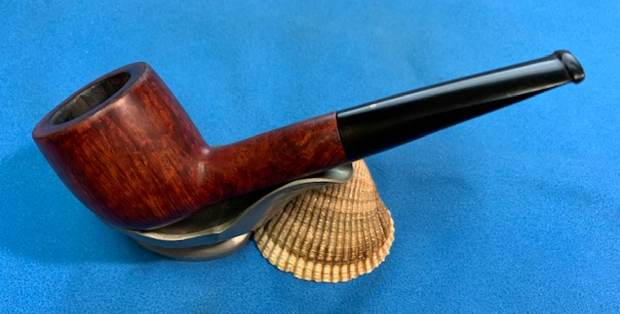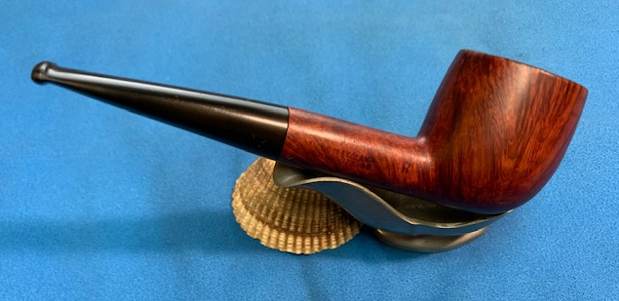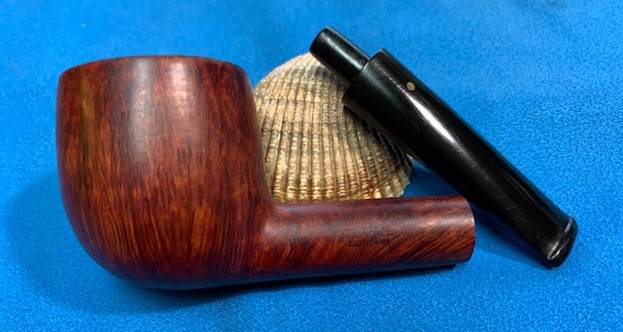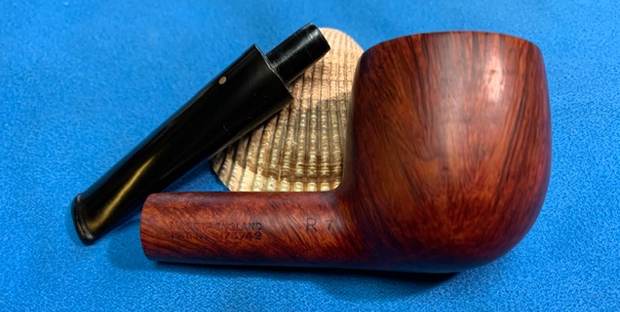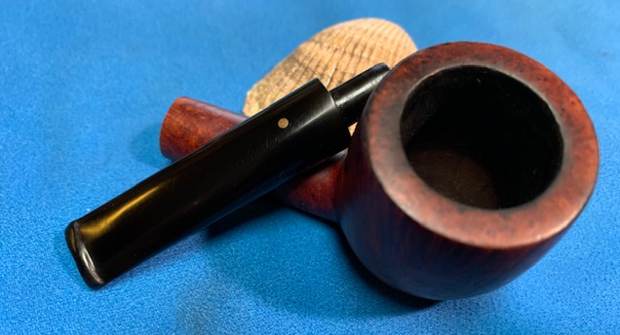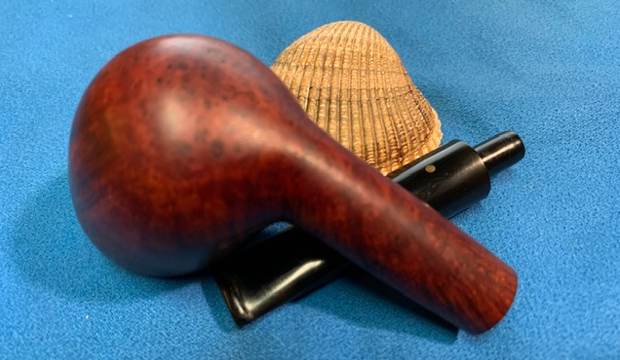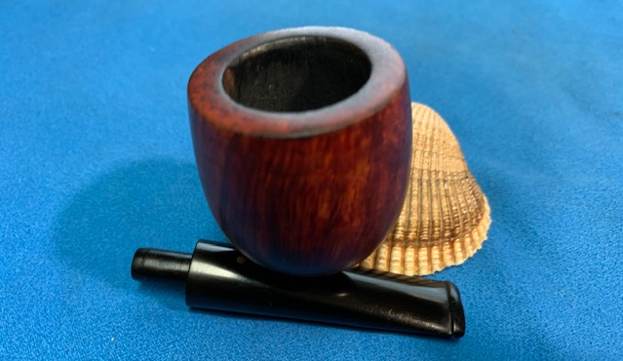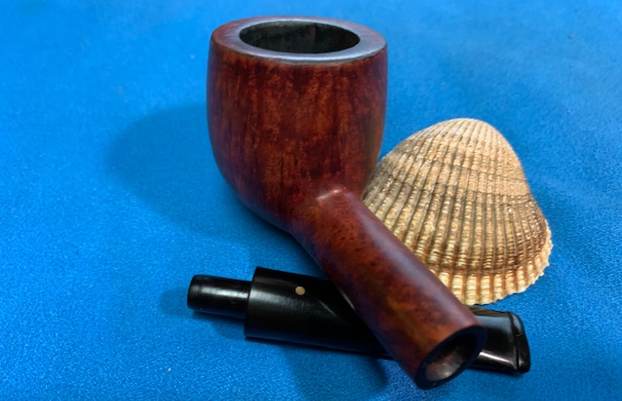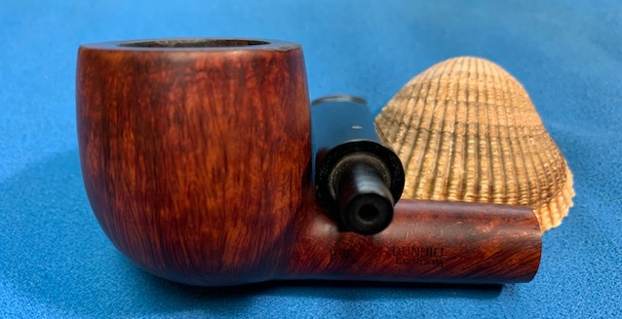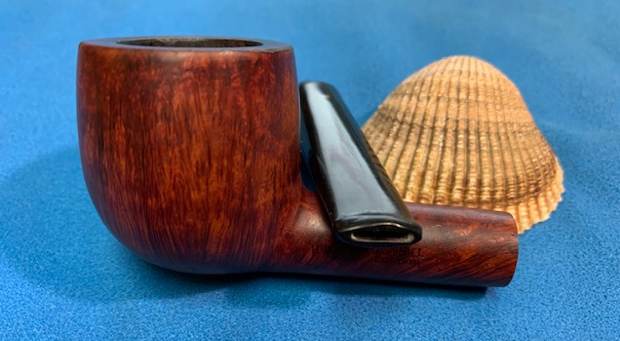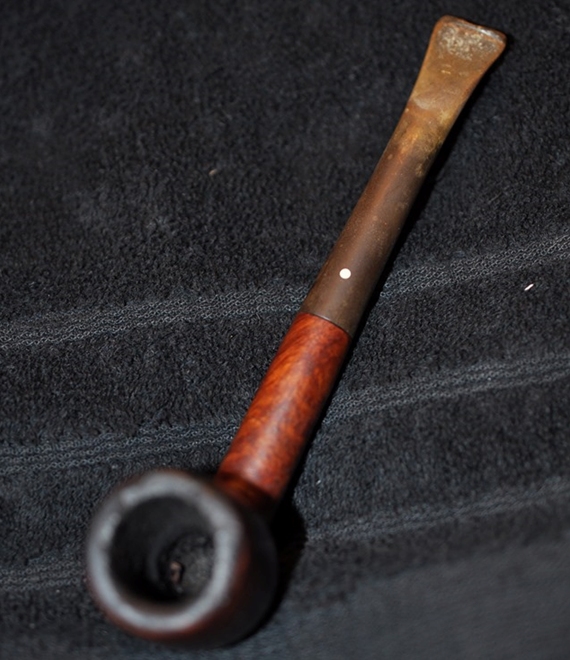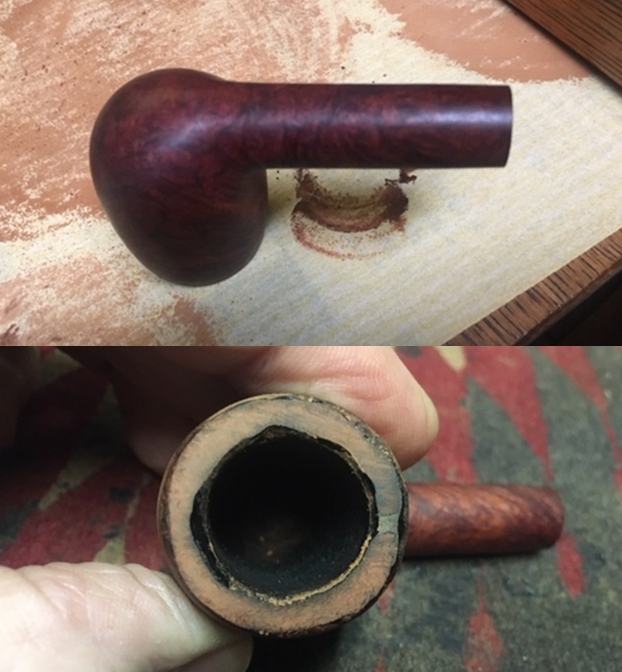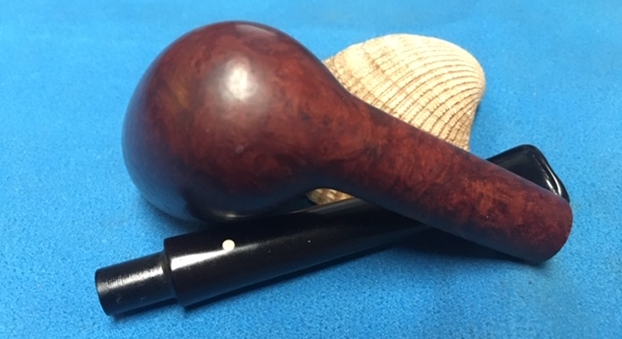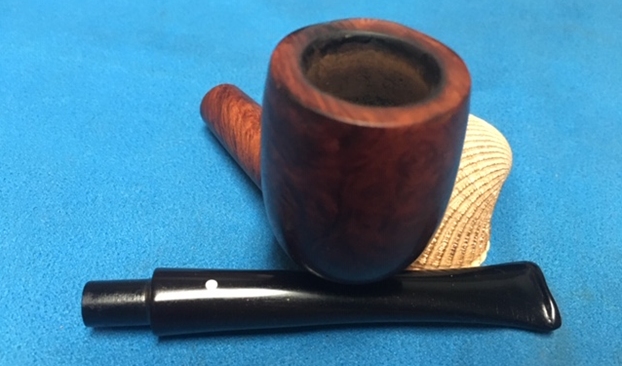Blog by Steve Laug
The next pipe on the table is another one that came to us from a group of pipes that Jeff and I purchased on 11/10/2022 from Copenhagen, Denmark. It is another Dunhill smooth finish pipe that is in rough but workable condition. On the left side it is stamped with the shape number 4R followed by Dunhill [over] London. On the right side it is stamped Made in [over] England followed by the date number superscript 0 after the D in England. Underneath that it reads Pat. No. 417574/34. After that it is stamped with a 3 in a circle [followed by] R for Root Briar. The stamping is faint but readable as noted above. The pipe has an brown coloured stain with some amazing grain that the shape follows well. The finish extremely was dirty. The bowl had a moderate cake and there was an overflow lava and darkening and damage on the rim top and both the inner and outer edges. The taper stem was in decent condition and was oxidized, calcified and had tooth marks and chatter ahead of the button. The stem was also missing a white spot so it is a replacement stem. Jeff took photos of the pipe to show what it looked like before he started working on it. 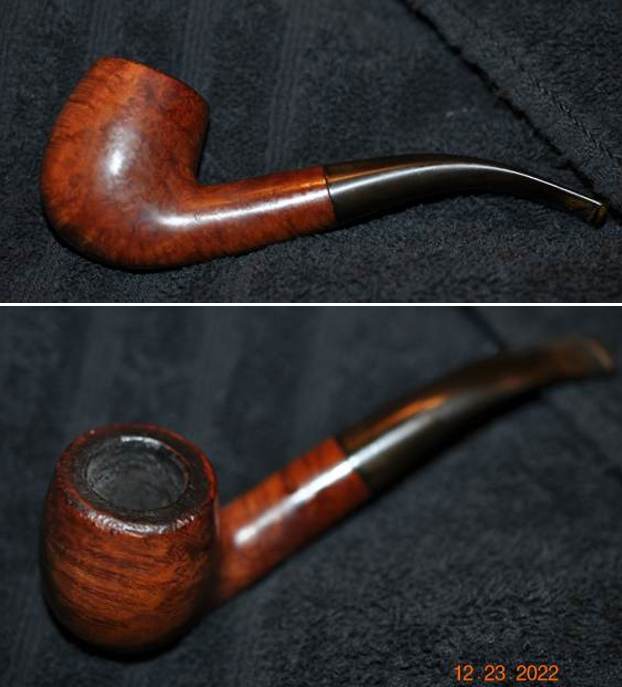 He took photos of the bowl and rim top to show their condition and of the stem to show the condition of both sides of the stem.
He took photos of the bowl and rim top to show their condition and of the stem to show the condition of both sides of the stem. 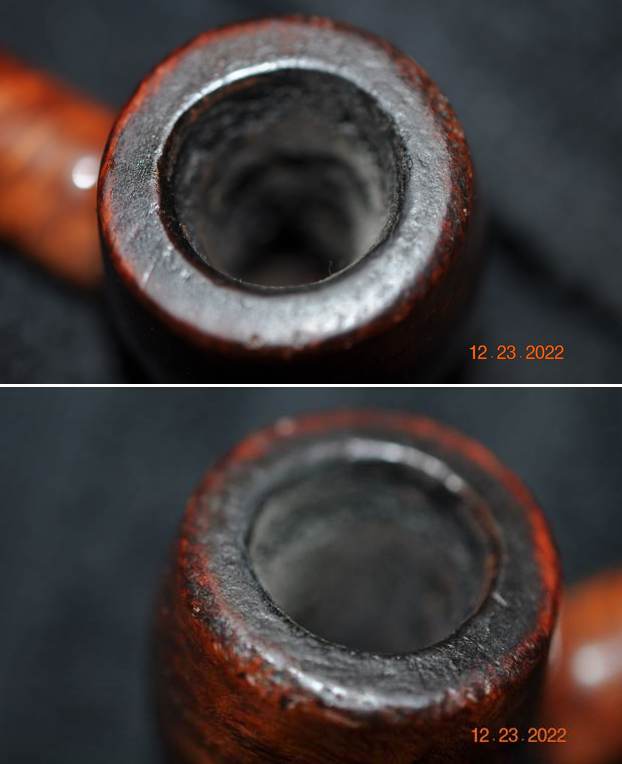
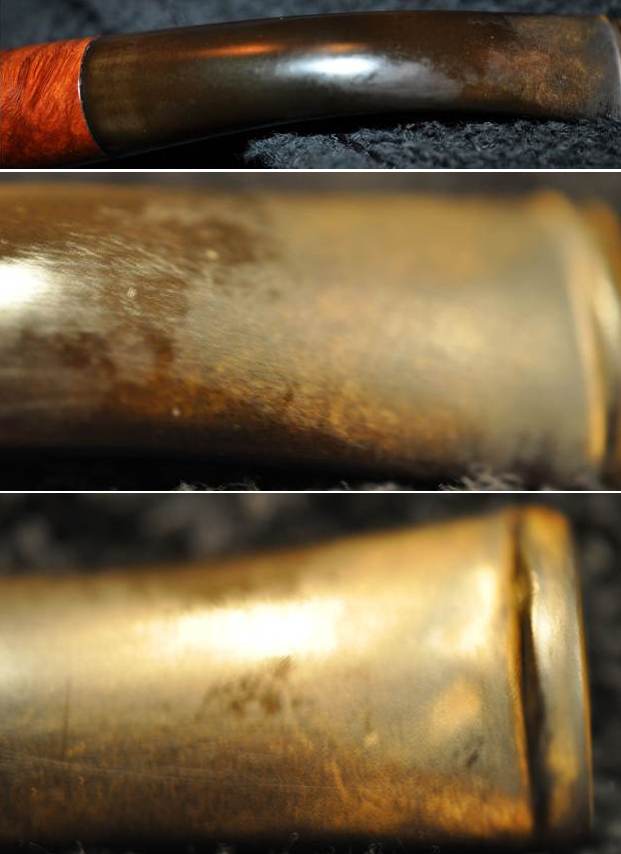 The photos of the sides and heel of the bowl show beautiful cross and birdseye grain and the Root Briar coloured finish on the pipe. Even under the grime it is a real beauty.
The photos of the sides and heel of the bowl show beautiful cross and birdseye grain and the Root Briar coloured finish on the pipe. Even under the grime it is a real beauty. 
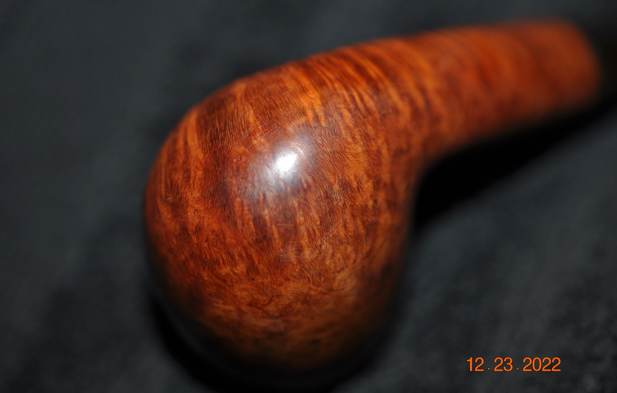 The stamping on the sides of the shank are shown in the photos below. It is faint but readable. It reads as noted and explained above. Jeff captured the detail in the photos below.
The stamping on the sides of the shank are shown in the photos below. It is faint but readable. It reads as noted and explained above. Jeff captured the detail in the photos below. 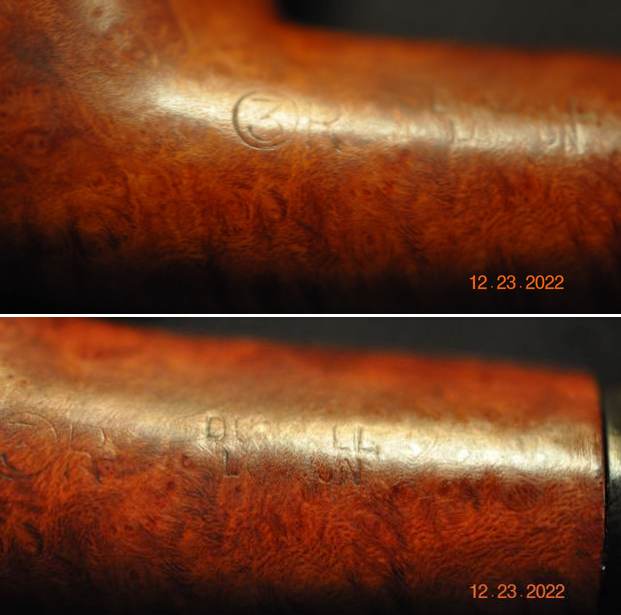
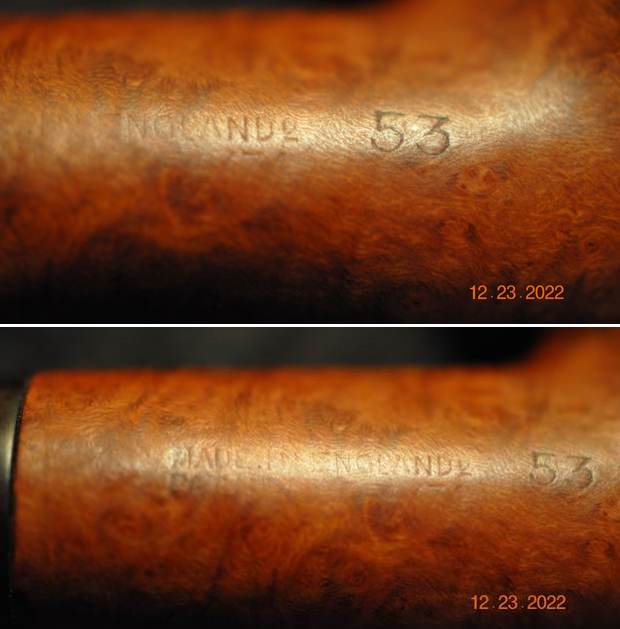 One of the first things I like to do is to unpack the stamping and understand each element in it. I turned to Pipephil’s helpful site (http://pipephil.eu/logos/en/dunhill/bruyere1.html). There was no pipe with the same Dunhill [over] London stamping on the Root Briar page but I can still work with the stamping. It can be interpreted as follows: The 53 stamp is the shape for a Billiard. The London stamp appears at times under Dunhill on older Root Briar and Bruyere pipes. The 0 following the D of England gives the date the pipe. The Circle 3 R refers to the size of the pipe being a Group 3 and the R is for the Root Briar designation.
One of the first things I like to do is to unpack the stamping and understand each element in it. I turned to Pipephil’s helpful site (http://pipephil.eu/logos/en/dunhill/bruyere1.html). There was no pipe with the same Dunhill [over] London stamping on the Root Briar page but I can still work with the stamping. It can be interpreted as follows: The 53 stamp is the shape for a Billiard. The London stamp appears at times under Dunhill on older Root Briar and Bruyere pipes. The 0 following the D of England gives the date the pipe. The Circle 3 R refers to the size of the pipe being a Group 3 and the R is for the Root Briar designation.
Pipephil also has some helpful dating keys on the site that are basically flow charts that you can walk through to date your pipe (http://pipephil.eu/logos/en/dunhill/cledat-en1.html). I turned to Part 1 of the Dating Key and followed the chart. This pipe has a 0 following the D in England. It is a superscript above the D so that took me to the section on the chart below (column one) which instructed me that the pipe could be dated as being “crafted between 1921 and 1954 Narrow down your dating”.  I followed the link following the “Your Dunhill pipe has been crafted between 1921 and 1954”. That took me to Page 2 of the dating key (http://pipephil.eu/logos/en/dunhill/cledat-en1b.html). The first column (suffix 0) led me to the section with a 0 after the D in England. There was a directive for dating the pipe to 1950.
I followed the link following the “Your Dunhill pipe has been crafted between 1921 and 1954”. That took me to Page 2 of the dating key (http://pipephil.eu/logos/en/dunhill/cledat-en1b.html). The first column (suffix 0) led me to the section with a 0 after the D in England. There was a directive for dating the pipe to 1950. I then turned to Pipedia’s section on Dunhill Root Briar to get a bit of background on the Dunhill finishes (https://pipedia.org/wiki/Dunhill#Root_Briar). I have highlighted the section below where the Dunhill [over] London stamp is explained. I quote:
I then turned to Pipedia’s section on Dunhill Root Briar to get a bit of background on the Dunhill finishes (https://pipedia.org/wiki/Dunhill#Root_Briar). I have highlighted the section below where the Dunhill [over] London stamp is explained. I quote:
 Root Briar – Introduced in 1931 and highly prized because the grain is more pronounced in this finish (usually made using Corsican briar – was made exclusively from that briar into the 60s). The Root Briar finish requires a perfectly clean bowl with excellent graining. Therefore, it is the most expensive of the Dunhill pipes. Corsican briar was most often used for the Root finish since it was generally more finely grained. This is a rare finish, due to the scarcity of briar suitable to achieve it. These pipes are normally only available at Company stores, or at Principle Pipe Dealers. Straight grained pipes were formerly graded A through H, but are now only “Dr’s” and graded with one to six stars, with the letters G and H still used for the very finest pieces.
Root Briar – Introduced in 1931 and highly prized because the grain is more pronounced in this finish (usually made using Corsican briar – was made exclusively from that briar into the 60s). The Root Briar finish requires a perfectly clean bowl with excellent graining. Therefore, it is the most expensive of the Dunhill pipes. Corsican briar was most often used for the Root finish since it was generally more finely grained. This is a rare finish, due to the scarcity of briar suitable to achieve it. These pipes are normally only available at Company stores, or at Principle Pipe Dealers. Straight grained pipes were formerly graded A through H, but are now only “Dr’s” and graded with one to six stars, with the letters G and H still used for the very finest pieces.
Dunhill introduced its third major finish, the Root finish, in 1931. Corsican mountain briar is characteristically beautifully grained and the Root was made exclusively from that briar into the 1960s. The pipe was finished with a light natural stain to allow the beauty of the graining to show through. Although always available with a traditional black vulcanite bit, the Root was introduced in either 1930 or more likely 1931 and fitted with a marble brown dark and light grained vulcanite bit that has since become known as the ‘bowling ball’ bit because of the similarity in appearance between the bit’s finish and that of some bowling balls of the time. With the war, however, the bowling ball bit was dropped from production. Through 1954 (and after) the Root pipe nomenclature (including shape numbers) was identical to that of the Bruyere except that instead of the “A” of the Bruyere, the Root was stamped with an “R”. In 1952 when the finish rather then LONDON was placed under DUNHILL, ROOT BRIAR rather then BRUYERE was used for the Root. Loring, J. C., The Dunhill Briar Pipe, The Patent Years and After (self-published, Chicago, 1998).
- See more examples here: Dunhill Root Briar
I have also included a chart from the site from Dunhill spelling out the Standard Pipe Finishes and giving short information and a timeline.  I turned to work on the pipe itself. Jeff had done an amazing cleanup of the pipe. He reamed the cake with a PipNet reamer and cleaned up that with a Savinelli Fitsall Pipe Knife. He scrubbed the internals of the bowl and stem with alcohol, cotton swabs and pipe cleaners. He scrubbed the externals with undiluted Murphy’s Oil Soap and rinsed the bowl off with running water. He soaked the stem in Briarville’s Pipe stem Deoxidizer and once it had soaked rinsed it off with warm water to remove the residual solution. He dried it off and rubbed it down to remove any oxidation that was still on the stem. The pipe looked very good when I received it.
I turned to work on the pipe itself. Jeff had done an amazing cleanup of the pipe. He reamed the cake with a PipNet reamer and cleaned up that with a Savinelli Fitsall Pipe Knife. He scrubbed the internals of the bowl and stem with alcohol, cotton swabs and pipe cleaners. He scrubbed the externals with undiluted Murphy’s Oil Soap and rinsed the bowl off with running water. He soaked the stem in Briarville’s Pipe stem Deoxidizer and once it had soaked rinsed it off with warm water to remove the residual solution. He dried it off and rubbed it down to remove any oxidation that was still on the stem. The pipe looked very good when I received it.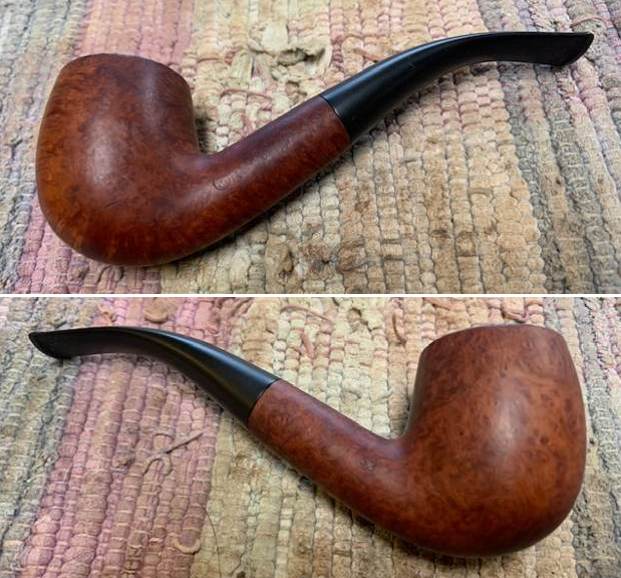
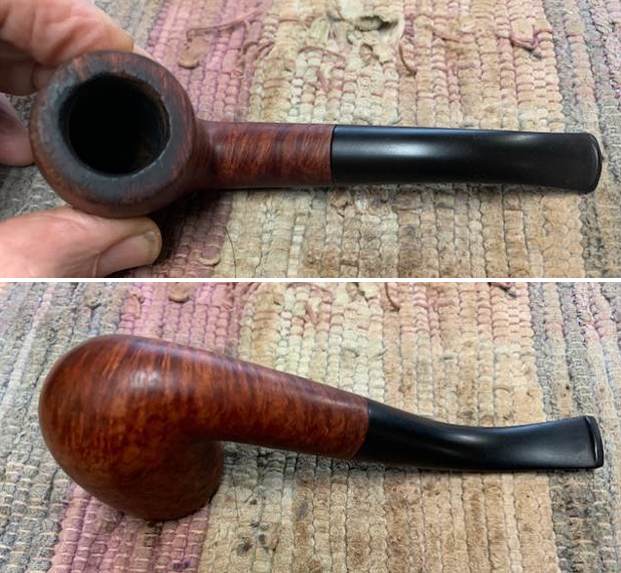 I took a photo of the rim top to show the condition. You can see the clean bowl and the damage on the rim top and inner and outer edges. The replacement stem came out looking quite good. There are some scratches, tooth marks and chatter on both sides ahead of the button.
I took a photo of the rim top to show the condition. You can see the clean bowl and the damage on the rim top and inner and outer edges. The replacement stem came out looking quite good. There are some scratches, tooth marks and chatter on both sides ahead of the button. 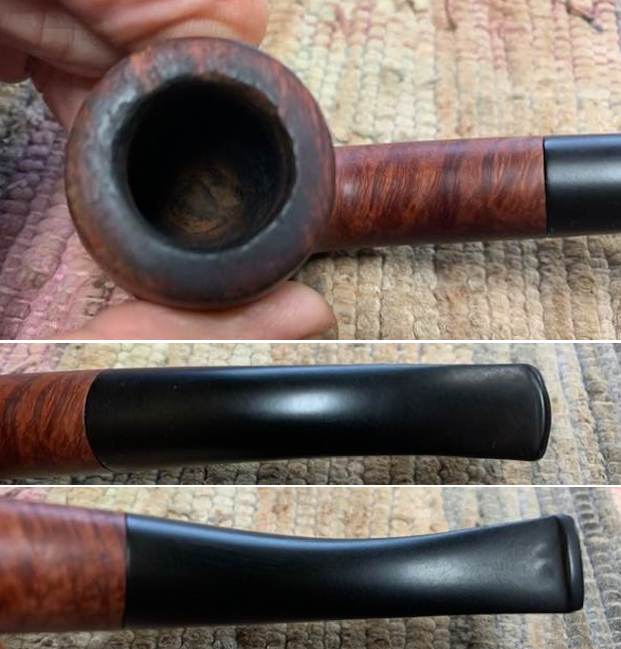 I took photos of the stamping on the sides of the shank. The stamping is faint in spots but still very readable. It reads as noted above.
I took photos of the stamping on the sides of the shank. The stamping is faint in spots but still very readable. It reads as noted above. 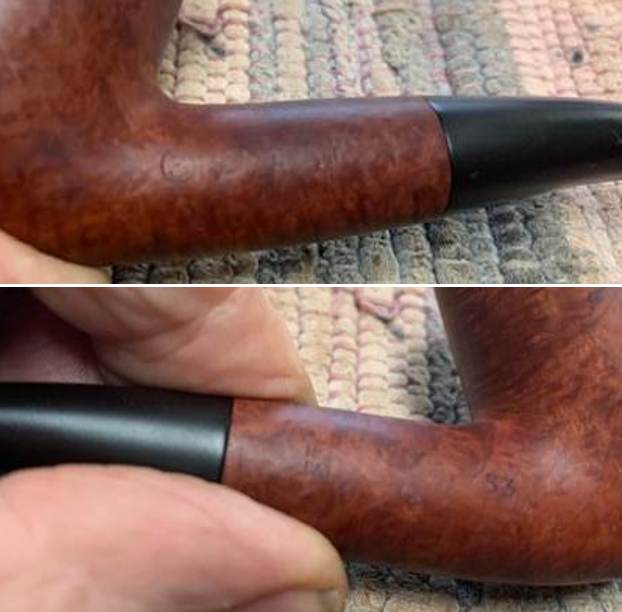 I removed the stem from the shank and took a photo of the pipe parts to show what I was working with. It is a nice looking pipe.
I removed the stem from the shank and took a photo of the pipe parts to show what I was working with. It is a nice looking pipe. 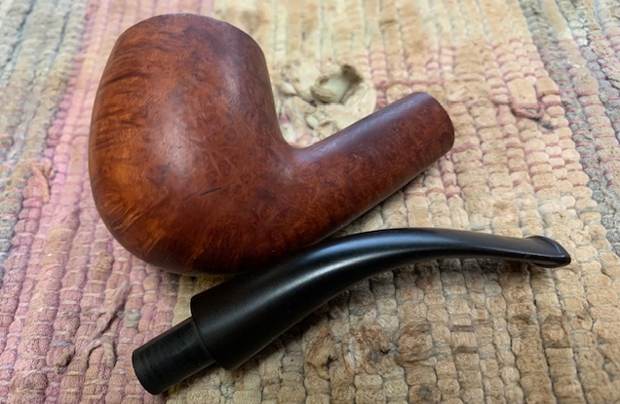 I worked on both the inside and outside edge and top of the rim with a folded piece of 220 grit sandpaper to clean up the damage. It would take some work but it looked much better.
I worked on both the inside and outside edge and top of the rim with a folded piece of 220 grit sandpaper to clean up the damage. It would take some work but it looked much better.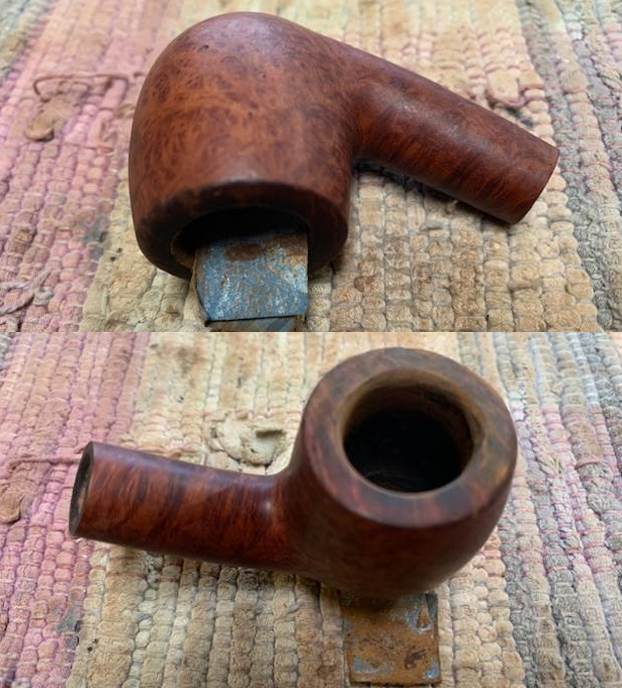 I polished the cleaned up rim top and edges with micromesh sanding pads – dry sanding with 1500-12000 grit pads and wiping the bowl down with a damp cloth to remove the dust. The rim top came out looking very good.
I polished the cleaned up rim top and edges with micromesh sanding pads – dry sanding with 1500-12000 grit pads and wiping the bowl down with a damp cloth to remove the dust. The rim top came out looking very good.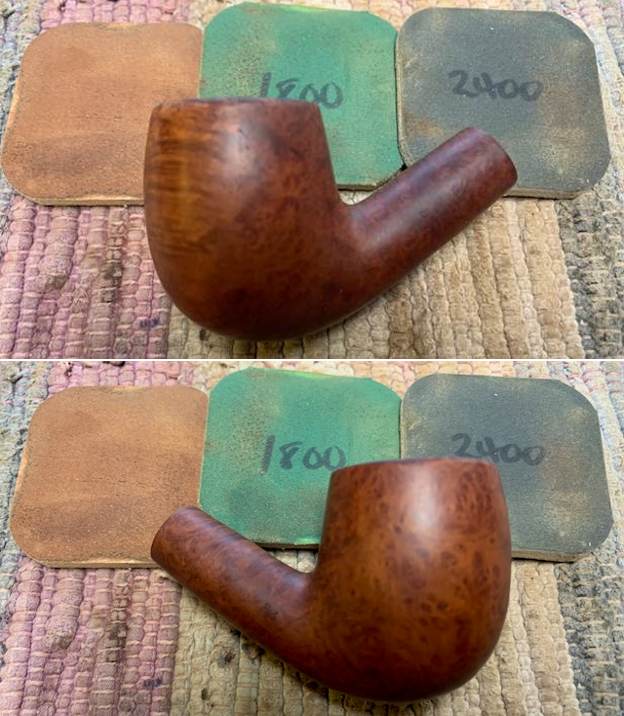
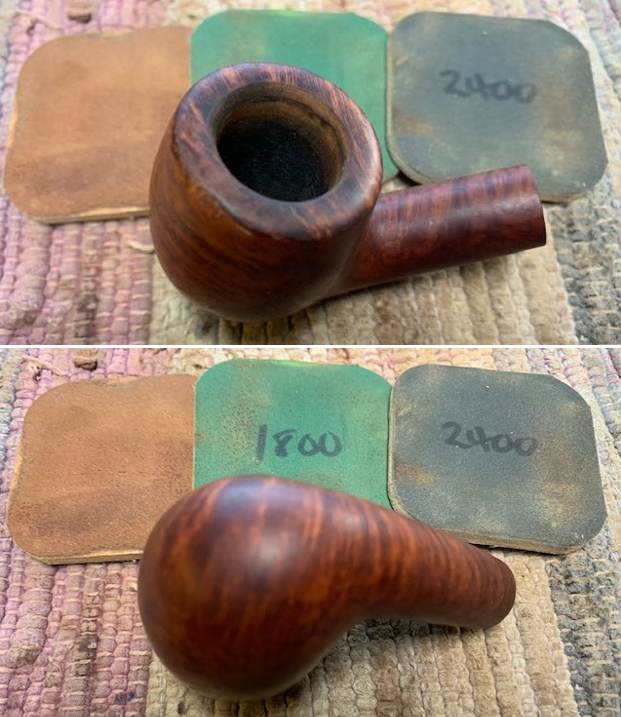

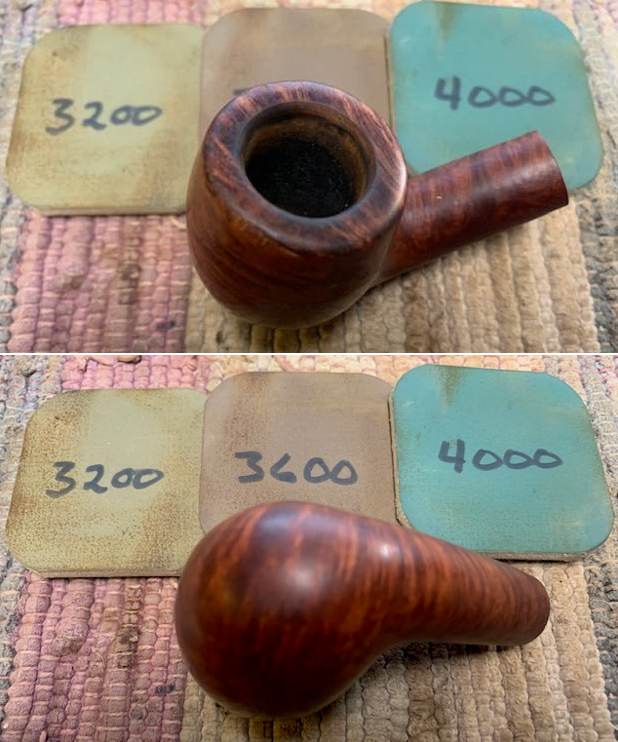
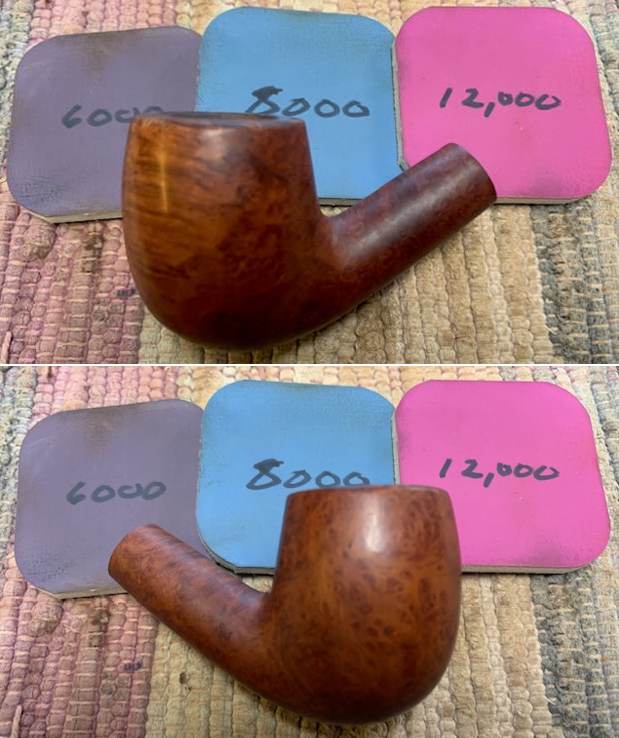
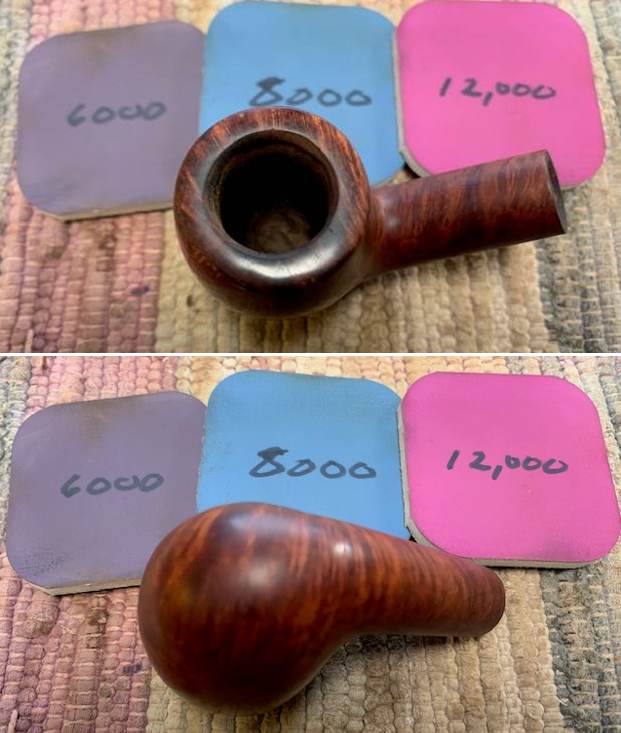 I rubbed the briar down with Before & After Restoration Balm. I worked it into the briar with my fingertips. The product works to clean, enliven and preserve the briar. I let it sit for 10 minutes then I buffed it with a cotton cloth to deepen the shine. The briar comes alive with the balm.
I rubbed the briar down with Before & After Restoration Balm. I worked it into the briar with my fingertips. The product works to clean, enliven and preserve the briar. I let it sit for 10 minutes then I buffed it with a cotton cloth to deepen the shine. The briar comes alive with the balm.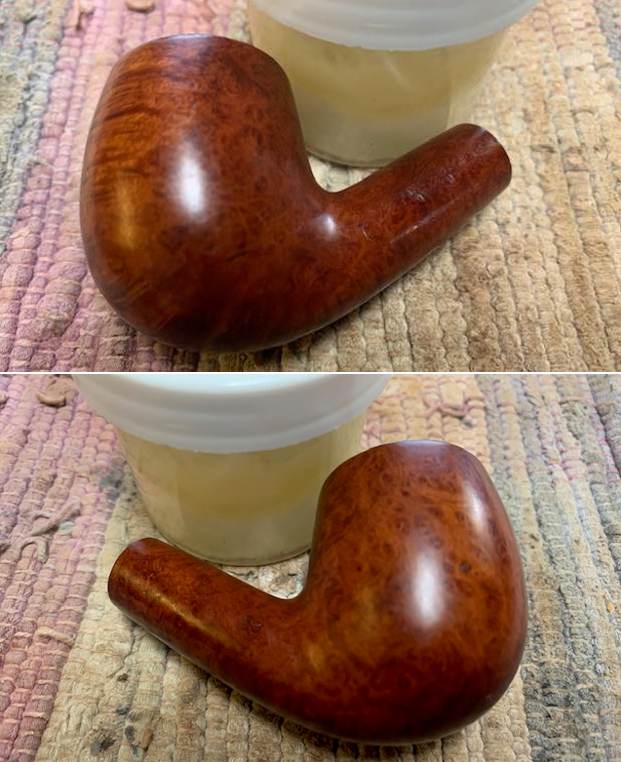
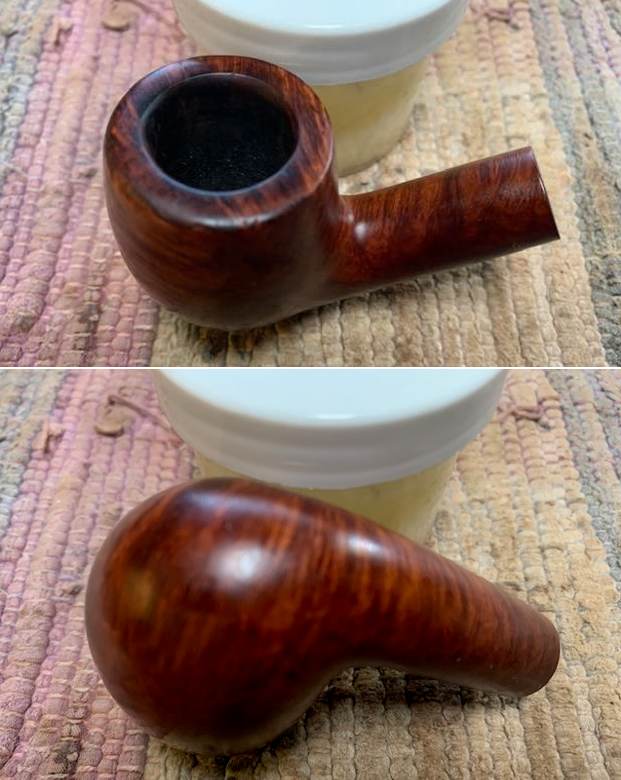
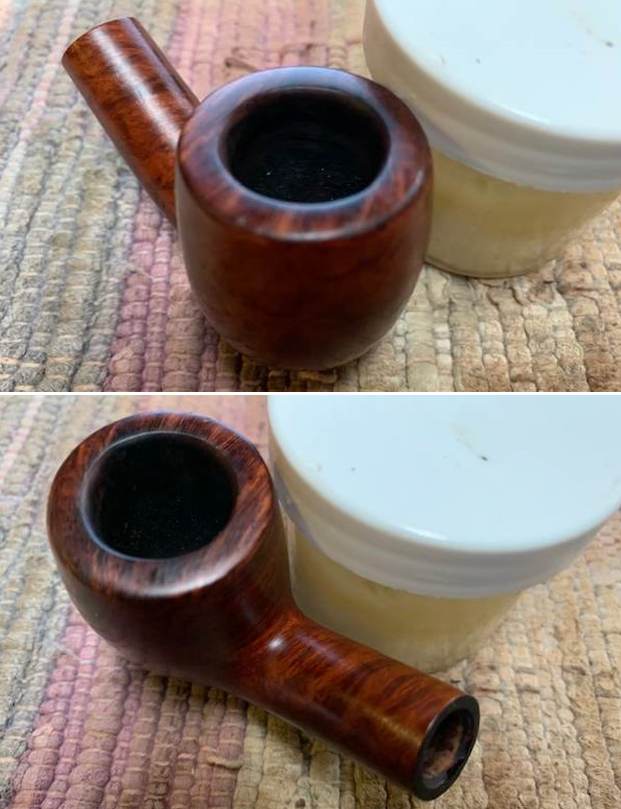 I set the bowl aside and turned to address the stem issues. I “painted” the surface of the stem with the flame of a Bic lighter. The heat lifted the tooth marks significantly. I filled in the small remaining marks with clear CA glue. I flattened them out with a small file once they cured. I sanded them with 220 grit sandpaper to blend them into the surface of the stem. I started the polishing with a 600 grit wet dry sandpaper.
I set the bowl aside and turned to address the stem issues. I “painted” the surface of the stem with the flame of a Bic lighter. The heat lifted the tooth marks significantly. I filled in the small remaining marks with clear CA glue. I flattened them out with a small file once they cured. I sanded them with 220 grit sandpaper to blend them into the surface of the stem. I started the polishing with a 600 grit wet dry sandpaper. 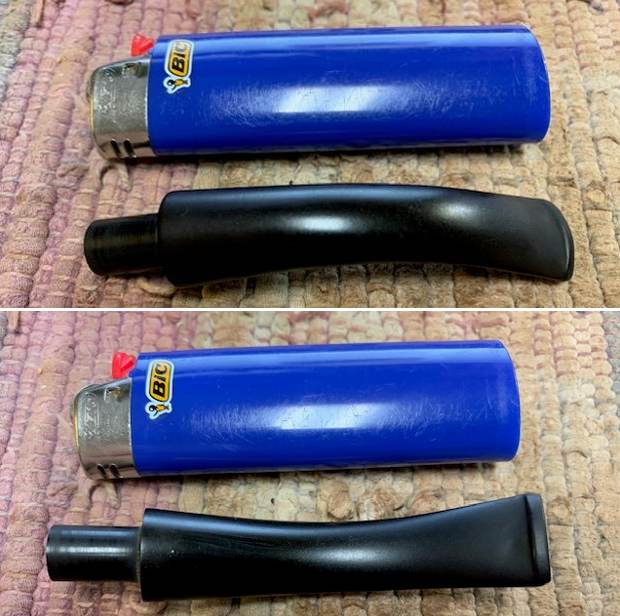
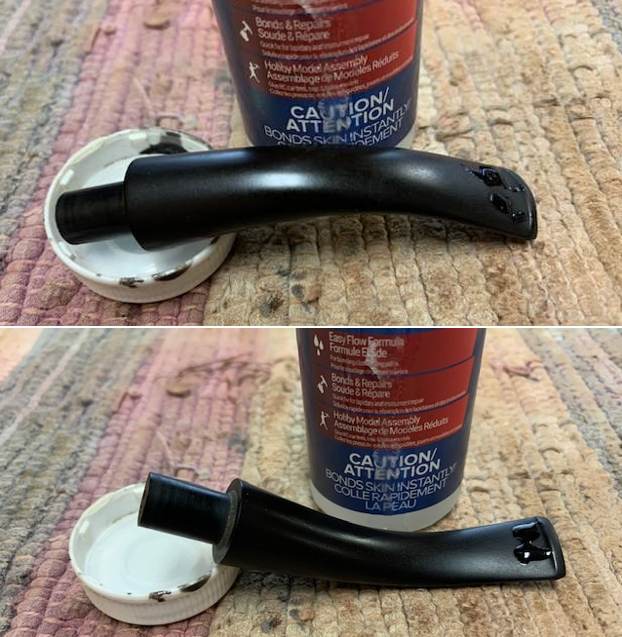
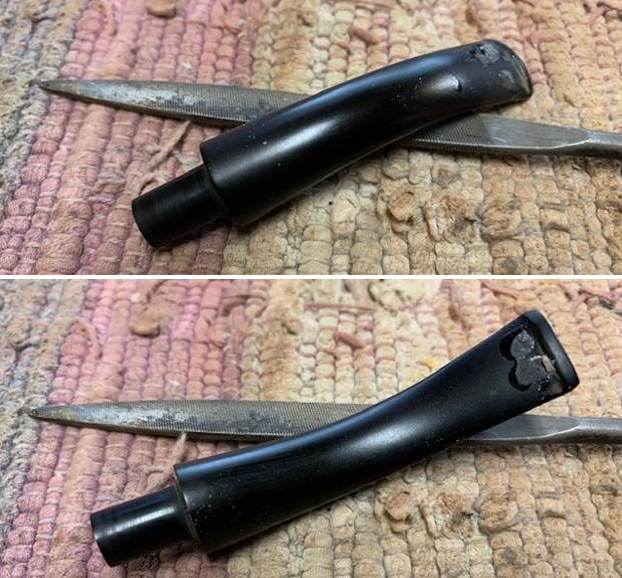
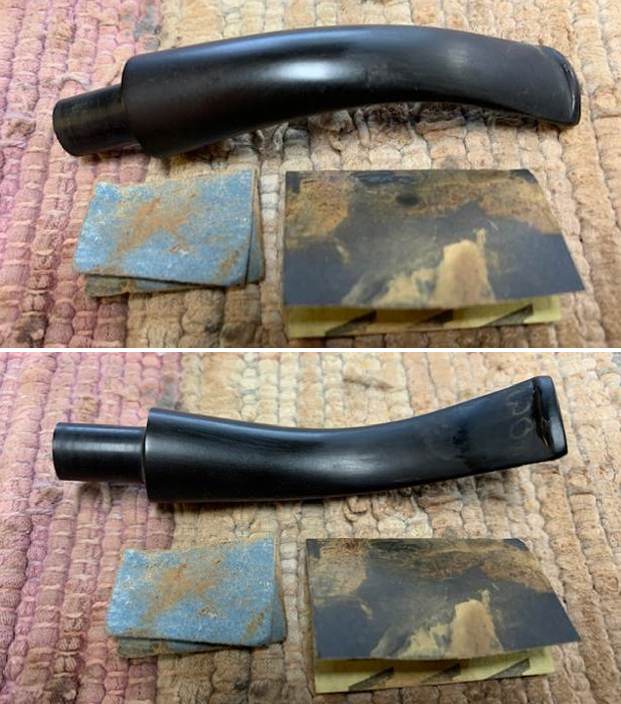 I polished the vulcanite with micromesh sanding pads – 1500-12000 grit pads. I wiped it down with Obsidian Oil after each sanding pad. I used Before & After Pipe Polish – both Fine and Extra Fine to further polish the stem.
I polished the vulcanite with micromesh sanding pads – 1500-12000 grit pads. I wiped it down with Obsidian Oil after each sanding pad. I used Before & After Pipe Polish – both Fine and Extra Fine to further polish the stem. 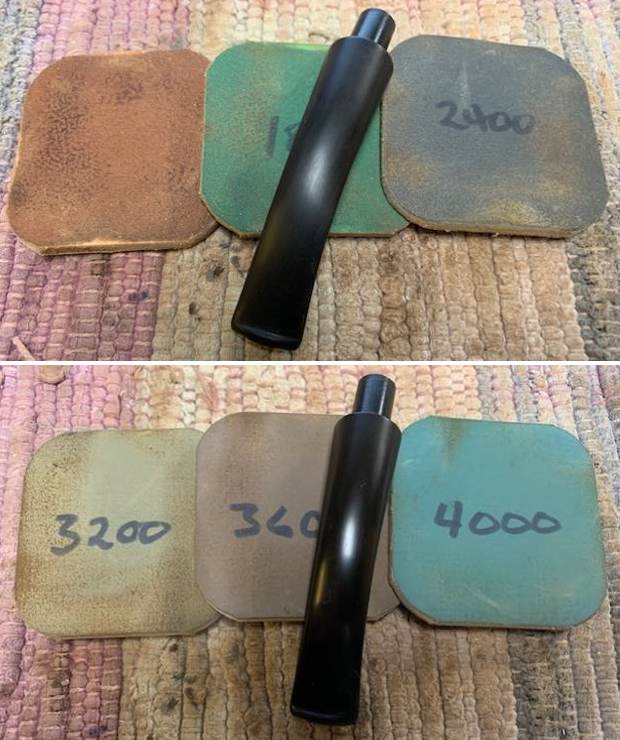
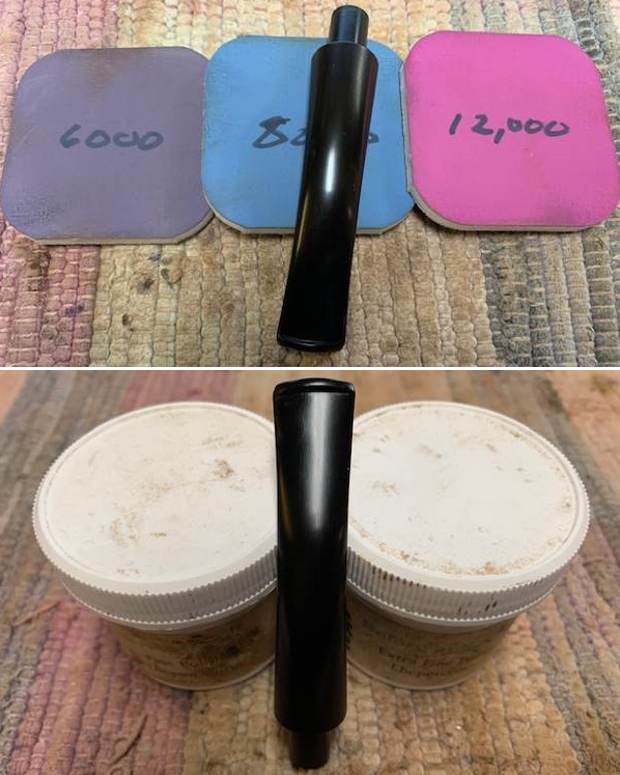 This 1950 Dunhill London Root Briar 53 Bent Billiard with a replacement taper stem has a smooth Dunhill finish that has some great grain. The polished mix of brown stains highlights some great grain around the bowl and shank. The polished replacement vulcanite taper stem adds to the mix. I put the stem back on the bowl and buffed the pipe with Blue Diamond on the buffing wheel being careful to not buff the stamping. I gave the bowl and the stem multiple coats of carnauba wax on the buffing wheel and followed that by buffing it with a clean buffing pad. I hand buffed the pipe with a microfiber cloth to deepen the shine. The finished 1950 Dunhill London 3R 53 Bent Billiard is quite nice and feels great in the hand. Give the finished pipe a look in the photos below. The dimensions of the pipe are Length: 5 ½ inches, Height: 1 ¾ inches, Outside diameter of the bowl: 1 1/8 inch, Chamber diameter: ¾ of an inch. The weight of the pipe is 1.45 ounces/41 grams. Thanks for walking through the restoration with me as I worked over another beautiful pipe. If you are interested in adding it to your collection I will be adding it to the British Pipe Makers Section of the rebornpipes store. Thanks for your time.
This 1950 Dunhill London Root Briar 53 Bent Billiard with a replacement taper stem has a smooth Dunhill finish that has some great grain. The polished mix of brown stains highlights some great grain around the bowl and shank. The polished replacement vulcanite taper stem adds to the mix. I put the stem back on the bowl and buffed the pipe with Blue Diamond on the buffing wheel being careful to not buff the stamping. I gave the bowl and the stem multiple coats of carnauba wax on the buffing wheel and followed that by buffing it with a clean buffing pad. I hand buffed the pipe with a microfiber cloth to deepen the shine. The finished 1950 Dunhill London 3R 53 Bent Billiard is quite nice and feels great in the hand. Give the finished pipe a look in the photos below. The dimensions of the pipe are Length: 5 ½ inches, Height: 1 ¾ inches, Outside diameter of the bowl: 1 1/8 inch, Chamber diameter: ¾ of an inch. The weight of the pipe is 1.45 ounces/41 grams. Thanks for walking through the restoration with me as I worked over another beautiful pipe. If you are interested in adding it to your collection I will be adding it to the British Pipe Makers Section of the rebornpipes store. Thanks for your time.